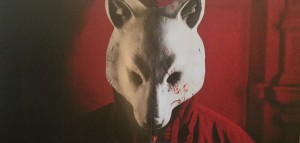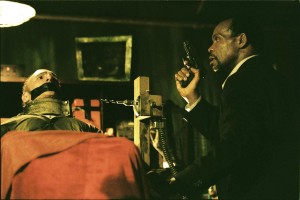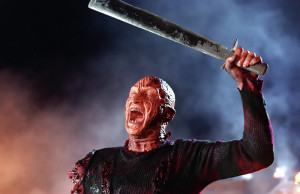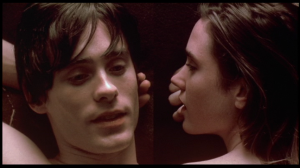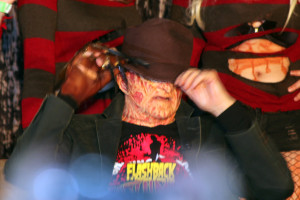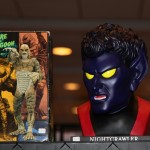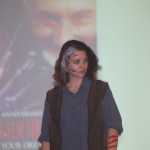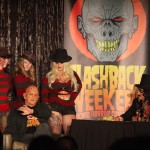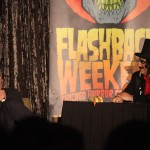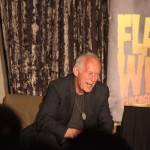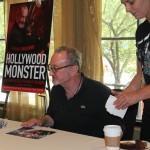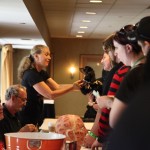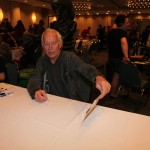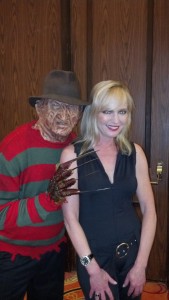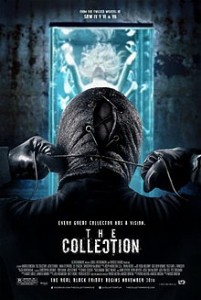Hellraiser – Pinhead’s JUDGMENT – A Video Interview With Paul T. Taylor
Hosted by Arnie Carvalho
In the tenth HELLRAISER film a new actor gets nailed with the starring role — Paul T. Taylor. In this video Taylor discusses his acting past, how he got the role, how the production went, and his hopes on how the new HELLRAISER: JUDGMENT is judged by fans!
Join Arnie and Paul now in this spoiler-free behind-the-scenes look at this upcoming Hellraiser film!
January 18, 2018 Posted by Arnie C | Movies, Movies & Television, News, Now Playing Podcast, Podcasts | Clive Barker, Direct-To-Video, Entertainment, Film, Hellraiser, Hellraiser Judgment, horror, Movies, News, Now Playing, Now Playing Podcast, Paul T Taylor, Podcasts | Comments Off on Hellraiser – Pinhead’s JUDGMENT – A Video Interview With Paul T. Taylor
PEELERS Review: This Zombie/Stripper Film Isn’t APEEL-ing, it’s Appalling.
Review copy provided courtesy of October Coast Publicity
I like zombies. I like strippers. So it seems zombie-strippers would be (pardon the pun) a no-brainer. But 2008’s Jenna Jameson/Robert Englund film Zombie Strippers fell in its high heels. 2012’s Zombies Vs Strippers failed to get a rise out of me. And defying my expectations, Sevé Schelenz’s new film Peelers is even worse than those two previous efforts.
Peelers’ concept is simple enough. When four coal miners accidentally strike oil they head to the Titty Balls Strip Club to celebrate. And it’s the club’s last night as owner “Blue” Jean Douglas, played by Wren Walker, has sold the club to a land developer who plans to shut it down. Soon their night of revelry turns into revulsion as the black ooze infected the miners turning them into bloodthirsty, mindless killers. No one in the club is safe, and the infection is spreading.
This set-up seems like a perfect throwback to ‘80s slasher films. I had low expectations for Peelers, but if it could give me base genre thrills along the lines of Prom Night 3 (yeah, part 3, not even part 1) or Friday the 13th Part VIII: Jason Takes Manhattan I would have given this film a solid recommend.
Sure enough, the film’s set-up seems to indicate that’s what I’ll get as we’re introduced to owner “Blue Jean”, her bad-boy brother Logan (Madison J. Loos), and the various strippers, bouncers, bartenders, and cooks that populate the Titty Balls. Instantly we see a large cast we know will lead to a decent body count. And it doesn’t take long before the miners arrive, and one begins regurgitating and transforming into a zombie.
And I was jazzed by some comic book cred. One character is named Logan, and another is Remy. I could chalk that up to a coincidence, but when the bartender drops a line about adamantium it’s obvious writer Lisa DeVita is an X-Men fan.
From there all the film had to do was coast on “cruise control” and give me some inventive kills along the way. Unfortunately first-time screenwriter DeVita can’t even accomplish that.
The set-ups in this film are so obvious I thought DeVita was trying to be funny. In the first fifteen minutes of the film we are introduced to what I can only call Chekhov’s arsenal: the strip club has a baseball bat, several handguns, and even, improbably enough, a chainsaw. Clearly every awkwardly-shown item will (and does) lead to later zombie defense.
But soon I realize the script wasn’t being ironic, it’s just poor. The plotting is confusing in several ways. For example, the miners believe they found oil, but it smells awful and converts them to zombies. Yet later we’re told it is still actual oil that can fuel your vehicle…and turn you into the living dead?
Beyond ridiculous, the script is downright ignorant. (Minor spoiler) The kryptonite for these oil monsters isn’t a gunshot to the head, it’s….water? The rationale is “Water and oil don’t mix” so, obviously, water will kill these bloodthirsty beasts?
Unlikely as it seems, the stupidity only escalates from there! The survivors in the club could just run away, but “Blue Jean” marshals them to stay and fight, lest these monsters go to the general population. Yet no one realizes that if they just wait out one good rainstorm then the problem will take care of itself.
Additionally, this group has every weapon known to god and man, but not one person has a cell phone?
If I gave the film the benefit of the doubt I’d say this was all intentional humor, but the leaden dialogue delivered by a cast of complete unknowns makes it all seem deadly serious. And deathly boring.
Yet I found myself slightly impressed with the production. Post-viewing research told me Peelers was a Kickstarter-funded film made for about $20,000. For that small sum Peelers achieved quality sound work, and decent camerawork. I looked up cinematographer Lindsay George and he has over a decade’s work on shorts and television. The result is a professional looking production that seems to make spectacular work of existing lights, and good effect of digital video cameras that work well in low-light conditions.
Some of the gore effects are also passable for cheapie-horror.
But if I’m complimenting a movie for saying it’s well lit, I’m stretching to find compliments. George is a good cameraman but he had nothing good in front of the camera to film. And several times he’s let down by poor staging and editing that makes action scenes downright confusing.
If you’re only requirement for this film is gratuitous nudity, yes, you’ll find it here, but every single bit of it is undercut by the most repugnant of “humor.” One stripper does her dance, only to end by giving guys in the front row a golden shower. Another stripper is late into her third trimester. I’ve been to a couple dive clubs in my life, but this is simply grotesque.
And yes, one zombie is indeed killed when the pregnant stripper’s water breaks on his head. If you think that sounds cool, you’ll still be bored as hell by Peelers.
It takes a lot to revolt me. The strippers here pulled it off. So…congratulations? But it wasn’t even in the fun Human Centipede way. More in the vein of “no one should have to watch this.”
Finally, the title Peelers was misleading. From the poster, showing an amputated stripper, and the title I thought I’d be watching a film about creatures that peel the skin off their victims. It would be the ultimate strip-club irony–a monster that continues to “undress” their nude victims. But these beasts just bite and gouge. The title, I suppose, references the strippers, but I’ve never heard a dancer called a “peeler” before. I suppose it’s a shame the title Striptese, Zombies vs Strippers, Zombie Strippers, Showgirls, and Zombeavers were taken. (FYI, every single movie listed there is more enjoyable than Peelers).
The end result is a film that seems to think it’s a cheapie From Dusk ‘Til Dawn rip-off, and ends up being so much worse than either of Dawn’s direct-to-video sequels. It’s not even fun in a so-bad-it’s-good way. It’s a mind-numbing 90 minutes that I will never get back.
The cover art reads “You may not get the happy ending you were looking for.” I certainly didn’t. Neither will anyone who watches this imbecilic production.
Congratulations to the film crew for accomplishing what they did on so little budget, but next time perhaps give that script a second draft before you start shooting.
July 14, 2017 Posted by Arnie C | Movies, News, Reviews | horror, Movie, Movies, News, Now Playing, Now Playing Podcast, Podcasts, Review, Reviews, Romero, Slasher, Strippers, Zombies | Comments Off on PEELERS Review: This Zombie/Stripper Film Isn’t APEEL-ing, it’s Appalling.
Soundtracks on Vinyl: You’re Next
One of the draws to collect vinyl releases of movie scores and soundtracks is the large artwork for the film that accompanies it. These entries will review the vinyl record release of a film score/soundtrack from the music to the artwork, as well as the film…
The Movie
You’re Next tells the story of a well-to-do family getting together in their home in the woods for a reunion. However, none of them seem very excited to see each other. Their ambivalence soon turns to terror and fear as a gang dawning animals masks invades the home and starts killing off members of the family. But the intruders meet resistance when one guest displays a special set of skills for fighting back.
I’m not one for slashers, but the striking posters for the film caught my attention. Each poster featured the close up of one of the intruders in a plastic animal mask (the lamb mask always stuck out to me) with You’re Next written out as painted in blood. Even the title had a simplicity that immediately expressed the mood of the film (it’s appeal similar to the title of Simon Pegg’s fake Grindhouse trailer for Don’t).
February 26, 2016 Posted by jakob | Movies, Music, Now Playing Podcast | horror, Movie, Review, Score, Slasher, Soundtrack, Vinyl, You're Next | Comments Off on Soundtracks on Vinyl: You’re Next
The 40 Year-Old-Critic: Snakes on a Plane (2006)
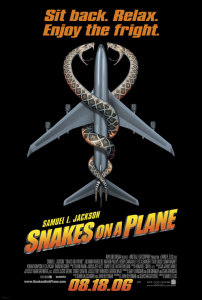 In The 40-Year-Old Critic, Venganza Media creator and host Arnie Carvalho recalls a memorable film for each year of his life. This series appears daily on the Venganza Media Gazette.
In The 40-Year-Old Critic, Venganza Media creator and host Arnie Carvalho recalls a memorable film for each year of his life. This series appears daily on the Venganza Media Gazette.
As I discussed in yesterday’s The 40-Year-Old Critic entry, I began my podcasting career in 2005 with the Star Wars collecting show Star Wars Action News; launched shortly after the release of Star Wars Episode III: Revenge of the Sith.
It had seemed like an easy enough hobby, we just record for 30 minutes each week.
However, the reach exceeded our every expectation, and in February 2006, we realized that recording from home wasn’t enough. All of the new Star Wars action figures and statues that would be released in 2005 had been revealed at Toy Fair International in New York City — and we weren’t there. We had our friends Pete and Chuck from the website Jedi Temple Archives call the show and share the news, but we knew we had missed out.
Pete and Chuck also told about the huge Lucasfilm and Hasbro presence at San Diego Comic-Con. New toys would again be revealed at the summer convention, and we felt Star Wars Action News should be there to cover it.
Marjorie and I had become more experienced con-goers since our first trip to Star Wars Celebration II for the release of Attack of the Clones, but we had never flown to an event. Airline tickets were expensive. Still, we had a show, and we needed the toys. Soon tickets were purchased, press passes obtained, and we were going to SDCC.
Then things got interesting.
As registered press for the convention, Marjorie and I started getting numerous e-mails from various companies seeking exposure. From toymakers to authors to movie studios, we were invited to exclusive events and given opportunities to interview total strangers.
Then came the e-mail that gave us the opportunity to interview Samuel L. Jackson and others for the upcoming film Snakes on a Plane.
I had heard about Snakes on a Plane but paid it little attention. Entertainment Weekly had written several articles about the silly movie with the overly-literal title. From the name alone hundreds of fan websites had sprung up. Despite its premise, the film had a groundswell of good buzz and the film’s producers wanted to capitalize on press coverage at the convention. With Jackson being a vital presence in the Star Wars prequels I thought an interview would certainly be of interest to Star Wars Action News listeners.
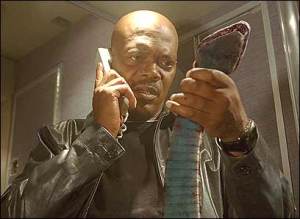
I like to imagine this is Jackson calling his agent wondering how he got on this Plane.
It seemed too good to be true. Jackson was an A-list star; I’d been podcasting for 9 months. I couldn’t believe it would actually happen. I told absolutely no one — after all, if it fell through I didn’t want to be mocked or thought of as a lying braggart. But I prepared: I bought a high-end digital audio recorder and I researched the film to be as informed as possible going in.
Yet the entire event could have been called San Diego Snakes-on-a-Plane Con. On the exhibit floor was a giant booth that was shaped like a snake, yet inside the mouth it had the feeling of a cramped airliner. The music video for Cobra Starship’s “Snakes on a Plane (Bring It)” was omnipresent (and I strained my eye every time it played for a glimpse of Maja Ivarsson’s nipple). We had gone to the convention with some friends who had just discovered the Badger Mushroom song, and so throughout the convention we’d regale each other with the refrain, “Snaaake! It’s a snaaake!” Our friends even brought rubber snakes to the convention as practical jokes.
I was swept up in the utter hype for Snakes on a Plane. I couldn’t wait for them to “Bring it.”
Sure enough, the next thing I knew I was in my first press roundtable interview. Jackson was the biggest star at the event, but it turned out there were four interviews in play. First, we interviewed director David R. Ellis, who I knew from his work on Final Destination 2. The other reporters at the table seemed disinterested and I got to ask a few questions.
Then we talked to the film’s snake wrangler Jules Sylvester. He wore an amazing serpent as he talked about the challenges of dealing with more than 450 snakes on set.
Finally, Sam Jackson visited our table.
Now the other reporters had perked up, and because I was still unaccustomed to the rhythm of the roundtable, I had to work hard to get questions in. I wasn’t entirely new to interviews; I had done many for journalism classes, and interviewed Star Wars collectors and authors on the show. But this was an A-list star. Jackson was there and actually joked with me a bit. It was surreal. He even gave me an autograph on a Star Wars book.
Finally the last interviewee came, Keenan Thompson, who Marjorie knew primarily for his work on Saturday Night Live. I got a couple of questions in there as well.
Leaving the interviews I realized I had far more content than I had thought. While the Jackson interview would be of some interest to Star Wars fans, the rest of the interviews were full of good information, though I knew they had no place on Star Wars Action News. Early feedback from Star Wars listeners was that they did not care for bad language, and so I figured the audience crossover between an R-rated reptile disaster film and Star Wars Action News was minimal.
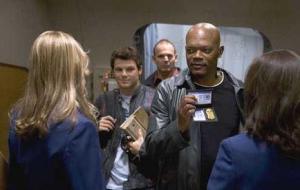
I’m not sure if a movie titled Snakes on a Plane needs more plot than, well, snakes on a plane. Yet this film also gives us a crime story to explain…sort of…how the snakes, and Sam Jackson, got on that plane.
But with four great interviews in the can I decided to start our second podcast, Snakes on a Podcast. It was a limited show, with only five episodes. The first four would lead up to the release of the movie and each would contain one interview. Then, for the fifth show, Marjorie and I would review the movie.
We publicized the show heavily on Star Wars Action News and it got a decent number of downloads. More, anticipation was high for our review; people wanted to know if we thought Snakes on a Plane was worth seeing.
Marjorie and I went to see Snakes opening night in August 2006. We had pre-purchased tickets, the Internet and Comic-Con hype convincing us it would be a sold-out show. It wasn’t.
More, the movie itself wasn’t very good, and we knew it in the theater. It wasn’t terrible, we had seen far worse that year, yet we had hoped for a pulpy B-movie full of laughs and fun. This was long before there was a Sharknado or Piranha 3D, but it was those films’ campy vibe that we hoped Snakes on a Plane would capture. There were moments of that in the film, but they were few and far between. The studio had initially made a PG-13 movie, then went back and added in scenes for the R-rating based off Internet fan demand for the line, “I want these motherfucking snakes off this motherfucking plane.” Those added scenes were what we wanted, that line was legendary, but in between moments of fun were long stretches of stupidity.
You can hear our thoughts, recorded minutes after leaving the theater, in the archived Snakes on a Podcast show. It is the first movie Marjorie and I ever reviewed in podcast form, and is the precursor to Now Playing Podcast, a show we started nine months later.
While the movie failed to meet our expectations, the theatrical viewing didn’t. It was an experience akin to The Rocky Horror Picture Show. While the theater wasn’t packed, everyone there was a built-in fan and the energy of the audience made for a good time. I have watched Snakes once since that theatrical viewing and it is clear that without the fans surrounding us there was little fun to be had.
Snakes on a Plane will always hold a special place in my heart. Not only was it the first time I ever felt like a real reporter for a podcast, it also is one of the last movies to consume San Diego Comic-Con. In the 2000s the complaints were that SDCC was no longer about comics; the fans had come for the movies. That was certainly true in my case. Hollywood studios saw SDCC as an opportunity to push genre movies to greater success, and spent hundreds of thousands, sometimes millions, of dollars at the convention trying to do so.
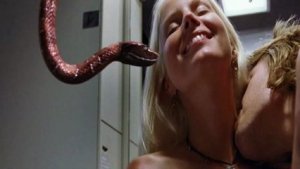
One of the films better, funnier scenes–added later to ensure an R-rating.
Despite the impressive imprint the movie had on the convention floor, Snakes on a Plane fizzled at the box office. Since 2006 a single film has always been pushed at the convention, from Hamlet 2 to Balls of Fury to Scott Pilgrim vs. the World, and they all failed to meet heightened studio expectations. Now it seems film studios have all but abandoned Comic-Con. The giant, custom booths that used to grace the floor are mostly gone. While stars still fly in to host one-hour panels, the convention has morphed into a showcase of genre television shows like Doctor Who, Game of Thrones and Arrow.
Yet each year I hope for another Snakes on a Plane-type experience, another extreme booth attempting to immerse fans in the world of their movie. It may not happen again, but at least I got these motherfucking snakes on this motherfucking Plane.
Tomorrow — 2007!
Arnie is a movie critic for Now Playing Podcast, a book reviewer for the Books & Nachos podcast, and co-host of the collecting podcasts Star Wars Action News and Marvelicious Toys. You can follow him on Twitter @thearniec
September 5, 2014 Posted by Arnie C | 40-Year-Old Critic, Conventions, Movies, Now Playing Podcast, Podcasts, Reviews | 2000s, Cobra Starship, Comedy, Enertainment, Film, horror, Movie, Movies, Now Playing, Now Playing Podcast, Podcasts, Review, Reviews, Samuel L Jackson, San Diego Comic-Con, SDCC, Snakes on a Plane | 1 Comment
The 40 Year-Old-Critic: Saw (2004)
![saw-poster[1]](https://venganzamedia.com/Gazette/wp-content/uploads/2014/09/saw-poster1-210x300.jpg) In The 40-Year-Old Critic, Venganza Media creator and host Arnie Carvalho recalls a memorable film for each year of his life. This series appears daily on the Venganza Media Gazette.
In The 40-Year-Old Critic, Venganza Media creator and host Arnie Carvalho recalls a memorable film for each year of his life. This series appears daily on the Venganza Media Gazette.
During the last decade, much of our national conversation was centered on torture, both in current events and entertainment.
We’d read headlines about waterboarding and rectally-inserted broom handles, leaving us questioning the purpose and moral justification for torturing prisoners of war. Then, when we turned the page to the Entertainment section we’d read about reality show contestants undergoing some form of painful humiliation for fame; while at the multiplex, a new sub-genre of film was emerging: torture porn.
The term was coined by New York Magazine writer David Edelstein in 2007, but his christening of the brand name came after the release of Saw, the film that put torture porn in front of the masses and defined the horror experience of the first decade of the 21st century.
With torture surrounding us in real life why would audiences pay money to see make-believe torment on screen? I think Americans are comfortable taking horrible scenarios and making them “safe” through fiction. During the September 11 attacks we heard stories about people so panicked by the oncoming fire that they jumped from the high windows of the Twin Towers. Their terrible choice was a nightmare for our nation, that thought of having to either burn or leap to your death. Yet with films like Saw writers and directors took that same life-or-death choice and, because it was a movie, made it safe.
With these films we in the audience could both sympathize with the tortured, while also desensitizing ourselves to the acts on screen.
Perhaps we needed fictional torture to help us accept what the nation was experiencing?
Or perhaps we just wanted to push the boundaries of experience a little further through film?
I know I was looking for something new in horror. After 1999’s successful The Blair Witch Project it seemed Hollywood was smitten with low-budget ghost stories. Recycled J-Horror found success, praised by audiences and critics. I saw those films, but I continued to seek something more; something that was more dangerous than a PG-13 rating would allow, a movie that would push my boundaries the way Hellbound: Hellraiser II had in the 1980s. I wanted more than a bit of spooky suspense found in films like The Ring and The Grudge. I wanted a visceral feeling of life stretched to its most extreme limit.
I had no idea that’s what I would find when I watched Saw.
The film was low-budget — barely more than $1 million — and made by filmmakers who were inspired by the scares Blair Witch delivered, despite that film’s smaller cast and even smaller cost. Saw creators James Wan and Leigh Whannell started by making a 30 minute proof-of-concept film. Its effectiveness helped them raise the money they needed to hire a cast of accomplished actors, including Danny Glover and Cary Elwes.
The story seems simple enough — two men are chained up together in a room, and a dead body separates them. They must uncover clues, or saw off their own feet, to escape. Yet, while keeping a small scope, Whannell’s script created the first iconic horror villain of the 21st Century: “Jigsaw” John Kramer. Played by Tobin Bell, Kramer was a man dying of cancer. With little time remaining he begins to set intricate traps for people to help them live the rest of their life to the fullest — or die trying to escape.
As Jakob, Marjorie, and I mentioned in our 2009 Saw Retrospective Series, the concept of Jigsaw was not terribly original. This mastermind is merely an iteration of John Doe from Seven, but with a dash of the self-fulfillment agenda of Fight Club’s Tyler Durden. After all, Jigsaw’s trap of making a suicidal man cut himself is not that different than John Doe’s punishment for “Lust”; death by intercourse with a bladed phallus.
Yet, despite the similarities, there is one key difference: in Seven we found almost all of John Doe’s victims after the fact. When Seven‘s main characters, two police detectives, discover “Sloth” he’s already wasted away, and “Pride” is already dead. In Saw the cast has expanded; our main characters are the victims of the trap and we get to watch them faced with their tests.
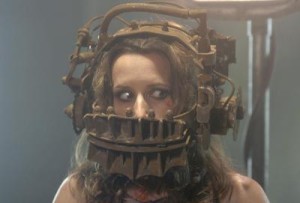
Shawnee Smith’s character Amanda escaped this trap to appear in five more Saw films.
More than just the two men in the room, the story grows to include more victims. Even for those introduced after an encounter with Jigsaw we still get to witness their torment in flashback. These scenes are myriad, from a woman in an iron collar that will tear her skull apart to a man, covered in napalm, having to hold a candle to read writing on a wall.
It’s not just that these victims were going to die in brutal ways (that was de rigueur for horror films since The Texas Chain Saw Massacre), but Saw upped the stakes by combining the suspense of impending horror. It was no longer just a killer behind the door, now there is a ticking clock and when it reaches zero someone will die, and in their last seconds they will harm themselves or others trying to escape.
These types of torment made waterboarding actually seem safe!
Though the creators of Saw would later claim the film was not torture porn, it was clearly the template for the dominant horror movement of the mid-2000s. Saw progressed through the scenes with characters put in increasingly more complex and convoluted traps, and I had the visceral reaction I’d sought. This movie did not scare me as Blair Witch did, but it repulsed me. I would flinch every time the next test came, knowing that the pain inflicted on the characters was fictional, but yet it hit home just the same.
The best part of it was that I was repeatedly asking the question: what would I do in those situations? Would I be able to cut off my own foot to escape a room? Could I kill a man in cold blood if the result was saving my own life? Could I take the pain of the razor cuts and escape the other side? And the absolute worst: could I shove both my hands in a shit-filled toilet to try and find a key?
Yet, a decade later I look back and wonder if subconsciously I made the connection between Elwes’ character, chained in a dirty shit-filled room, with those held in Guantanamo Bay. Neither the fictional character nor the real prisoner know if they will ever see daylight again, and both undergo horrible experiences before it ends… however it ends.
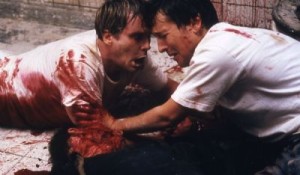
Dr. Lawrence Gordon (Elwes) and Adam Stanheight (Whannell) become brothers in blood on Saw’s dingy bathroom floor.
I can understand why Wan and Whannell would blanch at their hit being called torture porn. Porn usually indicates gratuitous sex (or sometimes action or gore) with no plot. Indeed, Saw has a plot as convoluted and twisted as any of Jigsaw’s traps. It’s clear to me that the two went through a lot of effort to create an involving story. Yet the fact remains that on my first watching I had trouble paying attention to the story for all that was thrown at me. It was a story that would become even more stretched and tangled as sequel after sequel followed, and for its labyrinthine complexity I actually grew to appreciate the franchise more.
Leaving that theater in 2004 I thought Saw wasn’t actually very good, but that’s because I was focusing on the plot (and the various holes it contained). Yet the images of the people in their torment stuck with me for quite some time.
More, as I previously stated, this film’s success created a new horror sub-genre, combining elements of the classic splatter film with the tropes of the slasher horror, yet drawing out the kill scenes in new and inventive ways. From the six Saw sequels to the Hostel films to The Collector to Turistas; each provided a new type of terrible vicarious experience. Truly the most extreme example in this sub-genre must be The Human Centipede — a film that I rejected in concept, but once its torture porn roots came through in the trailer I knew I was in for a treat.
But the genre burned out quickly. By 2009 Saw was clearly over, the sixth installment in the franchise losing a box office battle with the micro-budget found footage film Paranormal Activity. While a few more films, such as Saw: The Final Chapter and Human Centipede II were still to come, the election of President Barack Obama brought with it a shift in media attention away from Guantanamo Bay. That could be coincidence, but it seems more a causation — by the end of the decade humans were tired of facing torture, real or imagined, and preferred supernatural scares on screen. Their votes for political office matched their dollars spent at the box office.
As such, it seems torture porn will remain a symbol of early 21st century American movie-making. Yet out of that sprung some wildly inventive and visceral pictures that may yet inspire a future generation of filmmakers.
Tomorrow — 2005!
Arnie is a movie critic for Now Playing Podcast, a book reviewer for the Books & Nachos podcast, and co-host of the collecting podcasts Star Wars Action News and Marvelicious Toys. You can follow him on Twitter @thearniec
September 3, 2014 Posted by Arnie C | 40-Year-Old Critic, Movies, Now Playing Podcast, Podcasts, Reviews | 2000s, 40-Year-Old Critic, 9/11, Bush, Carey Elwes, Danny Glover, Enertainment, Film, horror, Jigsaw, Movie, Movies, News, Now Playing, Now Playing Podcast, Obama, Podcasts, Review, Reviews, Saw, Shawnee Smith, Terrorist, Tobin Bell, Torture, Torture Porn | Comments Off on The 40 Year-Old-Critic: Saw (2004)
The 40 Year-Old-Critic: Freddy vs. Jason (2003)
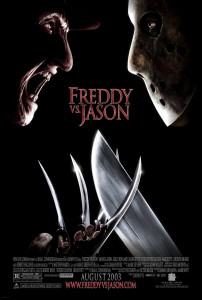 In The 40-Year-Old Critic, Venganza Media creator and host Arnie Carvalho recalls a memorable film for each year of his life. This series appears daily on the Venganza Media Gazette.
In The 40-Year-Old Critic, Venganza Media creator and host Arnie Carvalho recalls a memorable film for each year of his life. This series appears daily on the Venganza Media Gazette.
How many times will I review Freddy vs. Jason? It was one of Now Playing Podcast’s earliest reviews as part of our first retrospective series covering the Friday the 13th franchise leading up to the 2009 remake. Even then we planned to revisit the film and look at it from Freddy’s point of view, which we did the following year during the review series leading up to 2010’s A Nightmare on Elm Street.
By now this should be well-trod ground, and what more could I have to say?
Yet the fact that this is the only movie to be covered twice in Now Playing Podcast retrospectives is indicative of its importance — to film in general and to me personally.
Since our 2010 review I’ve spent a lot more time thinking about the crossover. What is it about two franchises coming together that creates such excitement, especially in the “geek” community? I don’t ask this hypothetically. I personally get swept up in the frenzy when two franchises come together, and it doesn’t even matter necessarily if I like them both! The thought of two universes colliding seems to have a geometric, not additive, increase in interest.
I think to some degree it is fan rivalry at its best. For reasons I don’t understand it seems some fans feel the only way to feel good about their fandom is by putting down others. For example, when Firefly was at its zenith a parade of “Joss Whedon Is My Master Now” shirts filled Star Wars conventions, as if to say, “Star Wars used to be cool.” As such, the “my dad can beat up your dad” mentality started to apply to fan groups; “My stormtrooper can beat up your browncoat.”
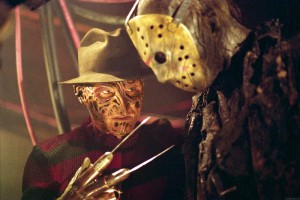
Freddy vs. Jason — whoever loses, the fans win.
That question of who would win in a fight certainly applies to superheroes. In real life, on screen, and online I’ve heard endless debates about which hero is faster, The Flash or Superman. Who would win in a fight, Superman or The Hulk? It is a curiosity, but the chosen winner usually aligns with the speaker’s fan allegiances.
Certainly, speaking of superheroes, comic books have benefited greatly from the crossover. DC Comics had a major hit with its Justice League in 1961, prompting Marvel Comics to respond with its own super team, The Fantastic Four, a move that inadvertently launched the entire Marvel Universe.
Yet, to me, the crossover seemed relegated to just that medium — the comic book. It seemed comics were pulp enough that you could do anything.
Aliens vs. Predator? Sure.
Robocop vs. Terminator? Why not.
Star Trek and X-Men together, you say? Absolutely.
Even rivals Marvel and DC had several crossover series’ that, for instance, led to Superman meeting Spider-Man or Batman fighting the Hulk.
Despite the success and excitement generated by these crossover comics, the concept was rarely conceptualized on film. Universal Studios had done it in the 1940s, when horror icons Dracula, Frankenstein and the Wolf Man came together for the studio’s “Monster Mash” pictures. But Universal owned each property, and when that series ended, crossovers on screen were scarce.
I can recall two that made an impact on me.
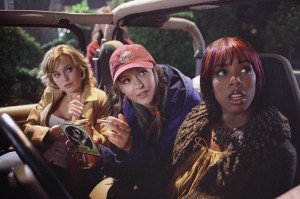
Freddy and Jason aren’t the only names in this cast. Monica Keena (Dawson’s Creek), Katharine Isabelle (Ginger Snaps), and Destiny Child’s Kelly Rowland play teens caught in the middle of the battle royale.
I remember being a young child on vacation with my parents when I saw a trailer for King Kong vs. Godzilla. I had seen numerous Godzilla films, and the 1976 King Kong several times. So the thought of them fighting broke my fragile little mind. I demanded we stay in the hotel room that night so I could watch.
Then, in 1988, Who Framed Roger Rabbit brought together animated characters from Warner Bros., Disney, Turner Entertainment, and more. As I was a teenager, and never really into these characters at my youngest age, the impact was totally lost on me. I saw the film in theaters, thought it was mediocre, and haven’t seen it since.
Beyond those two I can’t think of any groundbreaking crossovers. Some minor ones occurred; such as Star Trek: Generations bringing together cast members from two Trek television series’ (something that had already been done numerous times on Star Trek: The Next Generation, thus lessening the film’s impact). Also, The Monster Squad reassembled the classic Universal Monsters for a kiddie comedy.
But fans wanted more.
So many ideas were teased. Studios knew what we liked, so 1997’s Batman and Robin made sly references to Superman, and 20th Century Fox put an Alien xenomorph skull on a Predator ship in Predator 2. The latter seemed most likely to happen again on film — both franchises were Fox properties in need of a boost. Yet, outside of the Dark Horse comics, nothing materialized for years.
For me, though, more than Aliens and Predators, more than Superman and Batman, Freddy and Jason were the two I wanted to see. Long had the rumor brewed about Hollywood’s (then) top-grossing slashers, Jason Voorhees and Freddy Krueger, going toe-to-toe. I read about it in multiple Fangoria articles in the late 80s and early 90s.
I first saw A Nightmare on Elm Street during a party in 1987, around the time of A Nightmare on Elm Street 3: The Dream Warriors’ release. I found the films so inventive and fun that I rewatched them endlessly, and anxiously awaited each new installment in the series. As detailed during the Now Playing Podcast review, I even cosplayed for the release of Freddy’s Dead: The Final Nightmare. By 2003 I was happy for any new Nightmare, let alone one that pitted villain Freddy against Friday the 13th icon Jason.
I was never as big a fan of the Crystal Lake zombie as I was Freddy, but I did also enjoy the Friday the 13th series. Some of the first R-rated horror I ever saw was Friday the 13th when I came home to find older kids in my house watching it. I tried to join them but the carnage, specifically the decapitation at the end of the 1980 original film, had me fleeing the room. When I finally became a full-fledged horror hound in my early teen years I returned to the franchise when Jason Takes Manhattan was released. While the films lacked the visual panache of the Nightmare series I still enjoyed the films as a guilty pleasure. Over time the series grew in my esteem to be another favorite.

Freddy was killed by fire, but flames don’t slow down Jason.
As such, having both serialized slashers come together would be a dream come true. Or, if done wrong, perhaps a nightmare.
Yet despite the rumors in the horror press and the anticipation by fans such as myself, the killer crossover took 15 years to materialize. Full credit for finally bringing the crossover to screen in the 21st Century must be given to New Line Cinema.
The biggest problem in the 1980s and 1990s was the rights: Jason was owned by Paramount, Freddy was New Line Cinema’s cash cow. The studios tried to work together during the slasher heyday but each wanted to earn 100 percent of the profits by licensing the other’s character. Obviously, that never happened.
Eventually, though, profits started to dry up. Paramount had run Friday the 13th into the ground with crazy concepts like Jason fighting a telekinetic or taking Manhattan. When original Friday creator Sean S. Cunningham wanted to see the franchise continue, specifically with a Freddy crossover, Paramount had no interest. This gave New Line an opportunity. They licensed Jason from Paramount and went to work on Freddy vs. Jason.
While Jason’s creator wanted the crossover, Freddy creator Wes Craven had other ideas. The Springwood Slasher had been given what New Line considered a proper sendoff with 1991’s Freddy’s Dead: The Final Nightmare. But the sequel proved profitable and Craven started planning a return to his iconic franchise. As such, Freddy vs. Jason was put on hold and, instead, Wes Craven’s New Nightmare was made.
Cunningham bided his time, though. In 1993 Jason Goes to Hell: The Final Friday was released and ended with a fan-baiting stinger; Freddy’s glove comes out of the ground and pulls down Jason’s mask. The game was afoot!
We would still have to wait more than a decade for Freddy and Jason to properly share the screen. New Line executives knew the importance of finding the perfect balance between the two famous killers, and so more than a dozen pitches were drafted and subsequently rejected.
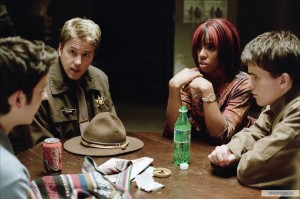
More victims caught in the middle of the killer clash.
Eventually I gave up all hope on Freddy vs. Jason. Nightmare star Robert Englund had not put on the makeup in almost 10 years and I thought Freddy would never grace the screen again. Jason, meanwhile, had gone to space with Jason X (which sat on a shelf for 2 years before its release). Finally, in the early part of the last decade, news — real news — started to come out that the movie was being made.
I honestly believe my excitement for Freddy vs. Jason was on par with my feelings about 1999’s Star Wars Episode I. A countdown clock sat on my computer desktop for 4 months, and when the day finally came I took an afternoon off work to see the first showing.
It met my every expectation.
Directed by Bride of Chucky’s Ronny Yu, the film was outrageous, gory, and over-the-top fun. Both characters got their due (even if Jason inexplicably was suddenly afraid of water) and I couldn’t have asked for more. You can hear a blow-by-blow analysis and both of my reviews at the Now Playing Podcast website, but in short I gave it a strong recommend both times.
Yet loving a movie isn’t enough to garner inclusion in this 40-Year-Old Critic series, there has to be a long-lasting impact. For Freddy vs. Jason, there were two.
First, this film gave Robert Englund a proper Freddy sendoff. It was the best film starring the dream stalker since 1988’s The Dream Master. It cemented a positive feeling for the Nightmare franchise that remains unsullied to this day. Just two weeks ago I had my photo taken with Englund, who was dressed in the full Freddy make-up. I even have ideas for a Nightmare inspired tattoo–the dream killer’s glove slicing into my skin.
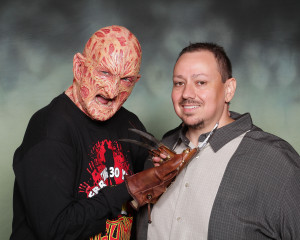
Freddy vs. Arnie — Robert Englund and Arnie pose for a photo at Flashback Weekends in Aug. 2014
Second, though, Freddy vs. Jason’s success launched more than a decade of franchise crossovers. The next year finally saw the release of Alien vs. Predator, which I anticipated every bit as much as Freddy vs. Jason — and which was an utter letdown.
Other pictures released that year include the low-rent, made-for-television crossover Puppet Master vs. Demonic Toys (co-written by Blade and The Dark Knight scribe David Goyer), as well as a return to the “Monster Mash” formula with Universal’s Van Helsing.
Yes, the track record for crossovers wasn’t stellar, but that was honestly my secondary concern — the primary concern was that they were happening. Finally, after decades of teasing, universes were being shared and the world of movies suddenly felt as open as the page of a comic book. But, after 2007’s Aliens vs. Predator: Requiem a shot of adrenaline was needed. I do think the crossover was starting to be seen as desperate, until Marvel Studios took it to the next level.
In 2008 Marvel released its first movie produced in-house: Iron Man. The film stood alone, introducing wide audiences to a superhero that was considered B-list at best. Yet Marvel took a page from New Line Cinema’s book: at the very end Nick Fury showed up to discuss “The Avengers Initiative.” This was the comic book equivalent of Freddy’s hand bursting up from the ground, and Marvel kept its momentum building toward the third-highest-grossing film of all time: The Avengers.
There is a direct lineage from Jason Goes to Hell to Iron Man, from Freddy vs. Jason to The Avengers.
So next spring when you buy your ticket for The Avengers: Age of Ultron (and then download the Now Playing Podcast review) think about the trailblazer that pioneered the modern crossover film: Freddy vs. Jason.
Tomorrow — 2004!
Arnie is a movie critic for Now Playing Podcast, a book reviewer for the Books & Nachos podcast, and co-host of the collecting podcasts Star Wars Action News and Marvelicious Toys. You can follow him on Twitter @thearniec
September 2, 2014 Posted by Arnie C | 40-Year-Old Critic, Comic Books, Conventions, Movies, Now Playing Podcast, Podcasts, Reviews | 1980s, 1990s, 2000s, 40-Year-Old Critic, Avengers, Comic Books, Comics, Crossover, Enertainment, Film, Freddy, Friday the 13th, horror, Iron Man, Jason, Movie, Movies, Nightmare on Elm Street, Now Playing, Now Playing Podcast, Podcasts, Review, Reviews, Ronnie Yu, Sean S. Cunningham, Slasher, Wes Craven | Comments Off on The 40 Year-Old-Critic: Freddy vs. Jason (2003)
The 40 Year-Old-Critic: Requiem for a Dream (2000)
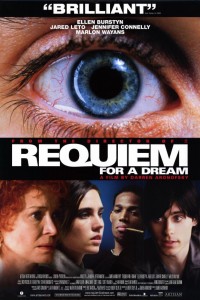 In The 40-Year-Old Critic, Venganza Media creator and host Arnie Carvalho recalls a memorable film for each year of his life. This series appears daily on the Venganza Media Gazette.
In The 40-Year-Old Critic, Venganza Media creator and host Arnie Carvalho recalls a memorable film for each year of his life. This series appears daily on the Venganza Media Gazette.
Have you ever seen a film that you instantly loved, but never wanted to see again? That was my reaction to seeing Requiem for a Dream in 2000.
I was drawn in by director Darren Aronofsky. I had seen his first film, the black-and-white techno thriller Pi, and was enthralled. The use of music, the sophisticated themes, the weird camera angles, the ideas of patterns in everything in life, the repeated sequences that formed a pattern in a movie itself about patterns; all of it left me entranced. I instantly knew Aronofsky was a talent to watch.
I anxiously awaited Requiem’s release, my excitement growing as I read high praise coming out of its screening at the Cannes Film Festival. Being a small film ($4.5M budget) with a very non-commercial NC-17 rating, I knew Requiem would not get a wide release. Sure enough, the picture opened on just 93 screens.
Like a character in an Aronofsky film, I was obsessed with seeing this movie. As such I made plans to visit my Now Playing Podcast co-host Stuart in Chicago, and there we would go see Requiem together.
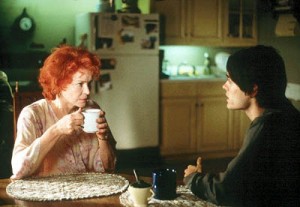
Burstyn and Leto share a rare scene together in Requiem for a Dream.
Based on the novel of the same name by Hubert Selby, Jr., the film follows nine months in the lives of Harry Goldfarb (Jared Leto) and his mother Sara (Ellen Burstyn). Despite the familial relation, the two characters rarely interact; their stories run parallel as we follow their hopes and falls. Starting in “Summer” and ending in “Winter”, the falling temperatures also represent the decline in the characters’ fortunes.
Harry is a heroin addict. He and his friend Tyrone (Marlon Wayans) have hit bottom so many times that stealing Sara’s television to pawn for drug money has become routine. After one theft, followed by a good high at the beginning of the film, Tyrone starts to show ambition –rather than just shooting up, the friends decide to resell some of their drugs to double their money. They have career aspirations of someday dealing a full pound of pure heroin that would set them up for a long time and allow Tyrone to move out of his bad neighborhood.
They start their plan — taking regular pauses to shoot up — and things start to go well. Harry even earns enough money to try to make amends with his mother, and buys her a new, modern television.
In addition to Harry’s burgeoning career as a drug dealer, he is madly in love with girlfriend and fellow junkie, Marion (Jennifer Connelly). The two dream of using their drug money to open a clothing store, allowing Marion to escape her controlling parents. With his money and his girl, things look great for Harry.
Sara, meanwhile, is also finding success. When the film begins she is an elderly widow living alone in an apartment, with little to do but watch self-help television shows. One day her fortune changes with a single phone call: she has been selected to be on her favorite game show. Sara is beyond excited, but also nervous about appearing on national television. A neighbor helps her dye her hair, with unfortunate results. She’s even more distressed after finding out the red dress she wants to wear on the show — one her late husband loved — no longer fits.

Sara starts popping the pills faster and faster to fit in that red dress.
After attempts at crash dieting prove unsuccessful, Sara visits a doctor and begins taking a heavy dose of diet pills. The amphetamines have severe side effects — Sara starts to grind her teeth and can’t sit still — but she loses 25 pounds and feels great. Her looming television appearance has made her the superstar among the retirees in her apartment building and she’s soaking it up.
When Harry brings his mother the new television he instantly knows Sara is tweaking on uppers. He tries to get her to stop, but she is too excited for the game show; even though her obsessive checking the mail for information about her appearance has yielded no results.
If you haven’t seen Requiem for a Dream, if you’ve only read the description above, you might think this is an ugly movie about despicable people. A heroin addict who steals from his own mother? A lonely old woman obsessed with television? A junkie aspiring to become a dealer? In so many movies these characters would be the villains, or at least the antagonists. But Aronofsky is a deft storyteller, and slowly he makes us care for each person on the screen.
Every character is given a touching moment. For Harry and Marion, it’s them lying in bed expressing their affection for each other. They don’t just say “I love you” — rather Harry uses the trite expression, “You’re the most beautiful girl I’ve ever seen.” She responds, telling him she’s heard that a lot, but adds that when Harry tells her it truly has meaning.
More than words, we see that scene through the points of view of both characters via split-screen, allowing for close-ups of Leto and Connelly. This unique approach drives home multiple points: a) they’re together, yet not, b) it’s the first sign that something will come between them, and c) the close-up shots convey intimacy, not isolation.
Then the shots get more inventive. We see Harry talk on one side of the screen, and on the other we see his hand caressing Marion, his thumb brushing over her lips, her palm. Then we see her close-up, and her hands on him. It’s not a sex scene, but this communion between two characters shows their relationship in a much more intimate setting. After only two minutes you want these kids to make it, yet their addiction hangs like a storm cloud.
The same goes for Harry and his mother. While he starts by stealing her television, causing Sara to lock herself in a closet away from her son, he still tries to assure her that everything will be okay. Later in “Summer” we see Harry and Marion on the beach, the man verbalizing how much he loves and cares for his mother and how, now that he has money, he wants to make right every wrong he’s done. It’s a deft turn, but thanks to Leto’s performance and earnest language, Aronofsky has made this thieving drug abuser actually seem noble and good.
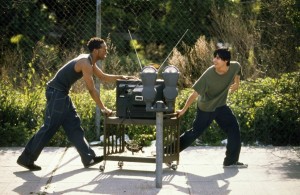
Harry and Tyrone take in some TV.
Tyrone is given the least background of the four, an odd choice considering he is the lead drug dealer. His girlfriend is never named, and his backstory is limited to a bit about honoring his dead mother. Still, Wayans gives a career-best performance in a rare, non-comedic role for the Scary Movie actor. Much of this is due to Aronofsky’s editing — one needs only to watch the deleted scenes on the DVD to realize Wayans tried multiple approaches to Tyrone, including a full-on Jar Jar Binks impersonation.
As shown on screen, Tyrone is the least developed character, yet still a likable personality thanks to the heart Wayans puts into the role.
It’s actually astounding that Requiem makes drug dealing seem like a bright, hopeful career path.
As for Sara, this character may not be one you hate, but one you pity. A virtual shut-in with a television obsession, it is again the script and the actress that makes Sara sympathetic instead of just pathetic. When Harry comes to tell his mother about the new television he asks why she cares so much about the game show appearance.
She responds at first by pointing out to Harry the reverential treatment she has been getting from the other biddies in her building:
“I’m somebody now, Harry. Everybody likes me. Soon, millions of people will see me and they’ll all like me. I’ll tell them about you, and your father, how good he was to us. Remember?”
Then after a pause, an even sadder truth comes out — this television show is all she has to live for.
“It’s a reason to get up in the morning. It’s a reason to lose weight, to fit in the red dress. It’s a reason to smile. It makes tomorrow all right. What have I got, Harry? Why should I even make the bed or wash the dishes? I do them, but why should I? I’m alone. Your father’s gone. You’re gone. I’ve got no one to care for. What have I got, Harry? I’m lonely. I’m old.”
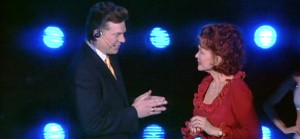
Sara hallucinates a visit to her favorite TV show, hosted by Tappy Tibbons (Christopher McDonald in a memorable minor role).
The obvious answer is right there: Harry could pay more attention to his mother. What she really needs isn’t another television, it’s human connection. But while Harry is desperately trying to be a good son he’s exacerbating his mother’s issue by allowing her to submerge deeper into television, versus helping her to escape it. Despite seeing his mother’s obvious bad reaction to the uppers, this is the last time Harry sees her.
Even with the obvious, unspoken truth of the scene, the monologue could have fallen flat if not for Burstyn’s amazing performance. She jitters while she plays the scene, expressing her agitation from the pills, with a nervousness at being so honest with anyone. She says the lines with a smile, but the sadness comes through in the delivery. Burstyn deserves every accolade she was given for this performance.
Finally, the mood is lightened with humor. When Harry and Tyrone steal the television it’s a joy watching them wheel it past all of Sara’s neighbors, who are more concerned with soaking up the afternoon sun than they are the obvious and strange theft. The characters laugh, joke, and keep the film from becoming too morose.
The combination of the amazing director, actors, and screenplay prevent this story from feeling trite or ugly. When “Summer” ends I was rooting for all four characters to achieve their dreams.
But if that was the summer, soon must come the fall, literally and metaphorically.
For Sara, this comes from her body building up a resistance to the amphetamines. She no longer gets her high from the pills, and though her red dress nearly fits, she needs to continue losing weight. When the doctor won’t up the dosage she self-medicates, taking multiple pills at once.
For Harry, Marion, and Tyrone, their downfall begins when a drug war breaks out in the city. Supplies of heroin have dried up — they can’t get any more to sell, and they can’t get any more to take. Their relationships are stressed, especially by Marion, who seems to suffer the worst withdrawal and blames Harry for her inability to shoot up.
By the time the film gets to “Winter” the movie is no longer a dark comedy. Each character becomes more desperate, and their ends are each so awful that Requiem for a Dream practically becomes a horror film. Yet none of it would work had we not cared for the characters — we would have applauded horrible people getting their just desserts. That I love these people and don’t want to see their ruination is the result of successful, manipulative storytelling of the best possible sort. Aronofsky made me like them, then pulled the rug out from under them — he did the same to us in the audience.

When I left the theater I was shaken and sad. The ending was depressing, but it was just; and I realized that. I felt as mournful as I would for a friend who’d gone down a bad road. This movie was hard — hard to watch, hard on its characters, and hard on the audience. I left the theater knowing I loved every frame of this film but also thinking it was such an emotional trial that I never wanted to watch it again.
I did though, many times. Beyond just great storytelling, Requiem for a Dream is a visual masterpiece that I — after some time passed — wanted to revisit to fully take in.
Aronofsky’s second feature brought back so many of the things I’d enjoyed in Pi, especially the inventive, experimental camerawork. Now, more than a decade later in a time when GoPro cameras are strapped to everyone’s heads, you see the genius in Aronofsky’s self-proclamed “Schnoz cam” — strapping the camera to an actor so the person always stays in the center of the frame while the background and scenery move around them. First used in Pi and then in Requiem, this gave the feeling of a character surrounded by a world out of control — a sign of madness, or a visual representation of vertigo. When sped up film footage is added to the effect, you see that Aronofsky created an entirely new way to deliver the same emotion as the old Hitchcockian “push and pull” change of depth.
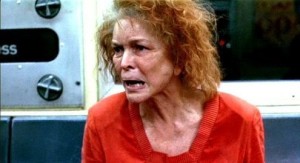
Sara finally fit in her red dress, but at what cost?
One of the things that impressed me about Pi was its unique visual style. Despite being very low budget, the use of superimposed images, quick cutting, and repetition was hypnotic. That is also on full display in Requiem. Every time the characters get high, be it by snorting, shooting up, or popping pills, a ritual is performed. The film cuts to a montage that lasts only seconds but shows the actions, and the characters. A lighter is lit, drugs boil, a syringe fills, blood courses through veins, pupils dilate. It all happens so fast that it’s virtually subliminal, yet it tells us everything we need to know. As the film becomes more desperate the montages are even faster, showing us people stuck in a cycle of self-destruction.
Aronofsky also isn’t afraid to get surreal. In the depths of psychosis Sara sees cupcakes floating in the air, her favorite self-help TV personality appears in her living room, interlaced at her television’s 480 lines of resolution. At one point her refrigerator even opens a gaping maw to eat her. These types of shots could undermine the mood but, as done here, they just enhance it.
In addition to the camerawork, enough credit simply cannot be given to composer Clint Mansell. I had the CD from Pi, his first film score, on an endless loop in my car; the electronic techno score was perfect for that film about a computer programmer, but I never would have thought the composer could hit the emotional resonance he did when he reteamed with Aronofsky for Requiem.
As this was a low-budget film, the score was performed by just four people: The Kronos Quartet. Still, with just violins, a viola, and a cello this score permeates nearly every frame of the movie. The low, sonorous tones of the cello dominate and make even the happy scenes foreboding. It’s a gorgeous composition that feels so classical it’s impossible to believe it was written in the 21st century; it feels like the work of Edvard Grieg, or one of Beethoven’s darker works.
The score has such an emotional resonance that it has been the breakout star of Requiem for a Dream; even if you’ve not seen this film I guarantee you’ve heard the score’s climactic movement, “Lux Aeterna.” Just two years later, in 2002, my jaw hit the floor when the trailer for Peter Jackson’s The Lord of the Rings: The Two Towers was scored to an orchestral version of “Lux Aeterna” — the assemblage of instruments and a faster tempo giving the song a more epic feel than the Quartet did alone (This orchestral version is available for digital purchase at Amazon).
In the years since, “Lux Aeterna” has been a go-to track for movie trailers, including Zathura, I Am Legend, Sunshine, The Da Vinci Code and, unlikely as it may seem, it was even used in Barbie doll ads!
Combined, every element of this film comes together as smoothly as one of Harry’s heroin montages. More, the performances, cinematography, and soundtrack all underscore the film’s thesis — summed up in the title — about the lengths to which people go to try and achieve their dreams. No matter what your dream, be it to be a TV star, a clothing shop owner, a screenwriter, or a podcaster, it’s a plight to which everyone can relate.
Aronofsky finally achieved mainstream success and acclaim with 2008’s The Wrestler, and then went on to even greater success with 2010’s Black Swan. I consider that unfortunate. While I like both of those films, the director has never achieved a more perfect theatrical representation of obsession than he did with Requiem for a Dream. And though I’ve yet to see this year’s Noah, my feeling is Requiem is Aronofsky’s best film to date.
Even if I do have to steel myself every time I rewatch it.
Tomorrow — 2001!
Arnie is a movie critic for Now Playing Podcast, a book reviewer for the Books & Nachos podcast, and co-host of the collecting podcasts Star Wars Action News and Marvelicious Toys. You can follow him on Twitter @thearniec
August 30, 2014 Posted by Arnie C | 40-Year-Old Critic, Movies, Music, Now Playing Podcast, Podcasts, Reviews | 2000s, 40-Year-Old Critic, addiction, Barbie, Darren Aronofsky, dealing, Drama, drugs, Ellen Burstyn, Enertainment, Film, Heroin, horror, Jared Leto, Jennifer Connelly, Lord of the Rings, Lux Aeterna, Marlon Wayans, Movie, Movies, NC-17, Now Playing, Now Playing Podcast, Podcasts, Requiem for a Dream, Review, Reviews, The Two Towers | 2 Comments
The 40 Year-Old-Critic: The Blair Witch Project (1999)
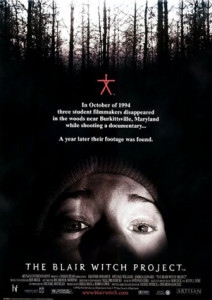 In The 40-Year-Old Critic, Venganza Media creator and host Arnie Carvalho recalls a memorable film for each year of his life. This series appears daily on the Venganza Media Gazette.
In The 40-Year-Old Critic, Venganza Media creator and host Arnie Carvalho recalls a memorable film for each year of his life. This series appears daily on the Venganza Media Gazette.
As I did with my 1980 review of Popeye, I do feel the need to address the elephant in the room: how can my pick for 1999 be anything other than Star Wars Episode I: The Phantom Menace?
It seems the likely choice. After 16 years a new, original Star Wars film was about to hit theaters, Lucas was directing for the first time in 22 years, and it was the top-grossing film of ’99.
Those who know me know how hyped I was for that film. I spent hundreds of dollars on toys and sat outside overnight in excessive rain, and later tremendous heat — third in line to get my ticket.
The Phantom Menace came and went, and when the year ended I realized the film had left me strangely unfulfilled. It defied expectations by actually making a Star Wars film boring. I have neither glowing nor damning things to say about Lucas’ return to directing. I’ll say this: It is certainly not a film that has impacted my life.
Instead, the film that stuck with me most from 1999 is not a big-budget Hollywood production, it is the smallest of films which became the year’s most profitable: The Blair Witch Project. I had never seen a movie like it before, and I’ll likely never experience one that way again.
The Blair Witch Project was more than a movie in 1999, it was a movement, and one that began months before it hit theaters.
I discovered The Blair Witch Project early in the year after reading about the film’s website, which was unlike any site I’d visited before. Odd and confusing, it told of Blair, MD, a town surrounded by superstition and mystery. I recall a timeline of events and some very low-res video. I also recall spending hours on this site, mostly waiting for the videos (which in today’s world would be tiny) to download to my 56kbps dial-up modem. The clips included news reports that seemed real enough, and introduced a mystery of three missing young people and rumors of the supernatural.
What the site didn’t mention was that it was all fictitious.
Have you ever wondered what it would be like to live in 1938, when an unsophisticated radio audience went into a panic over Orson Welles’ War of the Worlds? Or to be in 1974 and think there really was a chainsaw-wielding cannibal in Texas, instead of a story inspired by Ed Gein? The closest I will ever come to that is The Blair Witch Project. I found the site knowing of the film, but thousands didn’t — including some of my friends whose intellect I respected. They should have known better, but the age of the Internet hoax was not yet upon us.
This type of viral marketing is common now and thousands of movies have tried to replicate what Blair Witch innovated; but years before “viral video” was in our lexicon the Blair Witch website spread like wildfire via e-mails sent from person to person.
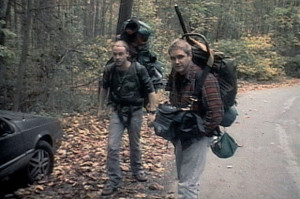
Josh and Mike begin their investigation.
From the presentation on the website, to the documentary-style filmmaking, it was very easy to be sucked into the “reality” of The Blair Witch Project. I watched as friend after friend fell for the ruse. Even as trailers for the film ran in theaters and on television, audiences weren’t sure if this was real.
“Don’t tell anyone,” I remember one friend confiding, “but I don’t think The Blair Witch Project is true.” I laughed and said, “Probably not, as I saw the lead actress on Jay Leno last night.”
Yes, even with a huge publicity push that involved multiple television appearances by the cast, audiences didn’t know what to make of The Blair Witch Project. That thousands of people could be so swept up in a shared fantasy, let alone one made by a few indie filmmakers and not Hollywood’s marketing machine, is phenomenal in the most literal sense of the word.
I went to see Blair Witch the weekend it opened. It had received so much acclaim in the media that I was excited to see the next evolution of horror. Plus I was curious; the website’s videos had asked many questions and I wanted to know the answers.
Initially I was put off by the filming technique. The early scenes introduce the three documentarians — Heather Donahue, Mike Williams, and Josh Leonard (all actors, but using their given names for the film) — as they set out to make a film about the myth of the Blair Witch. The early scenes have some comedic value and a bit of an eerie feel, but overall I wondered if I’d made a mistake. The shots seemed so amateurish and shaky. I knew this was low-budget filmmaking, but even in movies like Clerks and El Mariachi I’d never seen camera work like this — it felt like something I would shoot with my parents’ video camera and no tripod.
More, the characters seemed petty and dull. I knew they were actors, but they didn’t seem like very good ones. The bickering about a map, the various spats, I wondered when the horror would start.
But slowly the film sucked me in. Perhaps it was the first-person views, or maybe it was something instinctive — Heather’s constant cries for help breaking me down and stirring something primal inside me that is agitated by a female shriek. No matter, halfway through the movie, when Josh disappears, I was really invested in these characters and their plight. When Heather finds a small tied bundle and unwraps it I strained my eyes to see what was inside. There was blood and… were those teeth? Hair? It wasn’t gore like I was used to seeing; it was even more unnerving.
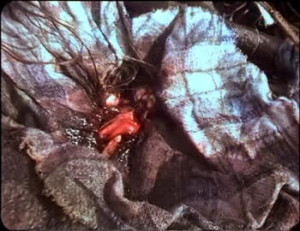
What… is… that?
By the time Heather, snot dripping from her nose, delivers her famous monologue to the camera I was totally taken. The Blair Witch Project did something no film had done since I was a child: it made me afraid. The tension of the scenes and the way it all felt so real; I had an uneasy feeling that I couldn’t just write off. The movie had gotten to me.
When the climax comes with Mike and Heather running through a house, then seeing Mike’s camera fall, I was dying to see more, to know more. Then, when Heather screams and her camera hits the ground and we see — is that Mike? Standing in the corner? I was enthralled, and frustrated. The film had provided no clear answers; what we saw could have been taken many different ways. But I had undergone the most exhilarating movie experience of 1999.
Among my audience I seemed to be the only one with that feeling. As credits rolled I witnessed something else I’d not seen before or since: a man around 50 stood up and shouted, “They must be pretty hard up for movies to put crap like that on the screen.” He left, disgusted.
That did not dampen my excitement. This was a movie unlike any I’d ever seen before, one that intentionally blurred the lines between fiction and reality (actors using their real names, regular citizens interviewed about a fictitious witch, etc.). More, the first-person filming technique had made me feel a part of the film.
According to Wiki, The Blair Witch Project was not the first “found footage” movie, but it was close, and it was the first that I had seen. Going in I had thought it unlikely I could find it believable that, in the midst of utter terror, these characters chose to keep the cameras rolling. Keep in mind this was before cell-phone cameras, YouTube, and the learned instinct of pulling out a camera every time tragedy occurs. Yet the way Heather, Josh, and Mike acted; their need for the security found through the camera lens, made me a believer.
That said, I thought it was a one-trick pony. Surely no film could pull this off again. How wrong I was. Blair Witch inspired a generation of filmmakers to try and replicate this formula. There were only seven “found footage” films released before Blair Witch; there have been more than 100 in the years since. Think about that.
Directors Daniel Myrick and Eduardo Sanchez were not trying to invent a new film style, they simply didn’t have the money for a full crew and improvised with actors, untrained in camerawork, filming each other. Yet now it seems impossible to escape this overused horror trope. I have seen so many “found footage” films, from Cloverfield to Chronicle to V/H/S to Diary of the Dead, and none have done it as well, or as believably, as Myrick and Sanchez did in 1999.
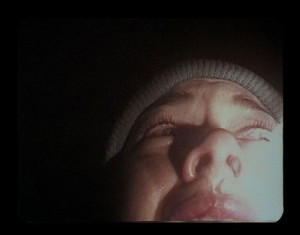
The scene you’ll never forget, and neither will Heather Donahue.
Initially I was drawn to Hollywood’s “found footage” trend, hoping to recapture that Blair Witch feeling. Now I avoid them at all costs, realizing the first was the best. In the end I like my movies to be cinematic. Blair Witch was a novelty but the constant output of more “found footage” movies has become a massive turnoff for me.
With Blair Witch as my first “found footage” experience I was shocked that my second wasn’t Book of Shadows: Blair Witch 2.
Released the following year, I remember taking Marjorie to see it opening weekend. While nowhere near as inventive, original, or tense as the first film, there were aspects of that sequel I enjoyed. The post-modern idea of “The first film was a movie in this second film!” was novel, and the hard rock soundtrack was fun.
My love of Blair Witch continued, though the property continued to be watered down. I bought all three videogames, and even the Blair Witch action figure. Yes, McFarlane Toys made two figures of a character never seen on-screen.
I have since escaped the Witch’s spell. I sold the figures, and the games were a dull mess. I haven’t seen the sequel since its DVD release in 2001. Yet the Blair Witch Project is a film I still hold in high regard.
Tomorrow — 2000!
Arnie is a movie critic for Now Playing Podcast, a book reviewer for the Books & Nachos podcast, and co-host of the collecting podcasts Star Wars Action News and Marvelicious Toys. You can follow him on Twitter @thearniec
August 29, 2014 Posted by Arnie C | 40-Year-Old Critic, Movies, Now Playing Podcast, Podcasts, Reviews | 2000s, 40-Year-Old Critic, Blair Witch Project, Enertainment, Film, Found Footage, horror, Indie Film, Movie, Movies, Now Playing Podcast, Podcasts, Toys | Comments Off on The 40 Year-Old-Critic: The Blair Witch Project (1999)
The 40 Year-Old-Critic: Scream (1996)
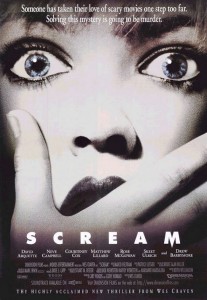 In The 40-Year-Old Critic, Venganza Media creator and host Arnie Carvalho recalls a memorable film for each year of his life. This series appears daily on the Venganza Media Gazette.
In The 40-Year-Old Critic, Venganza Media creator and host Arnie Carvalho recalls a memorable film for each year of his life. This series appears daily on the Venganza Media Gazette.
What’s your favorite scary movie?
As I mentioned in previous reviews of Love at First Bite and Hellbound: Hellraiser II, I have always been a horror fan.
As a very young child I loved the fear I felt toward forbidden cinema, and as I aged I came to see the humor, thrills, and scares in the genre. In my 20s, though, my love of horror changed. I had grown up and no longer had exciting nightmares starring Freddy Krueger. To me, there were no more mysteries in the world, and no more scares to be had on screen.
This problem was exacerbated by a lack of exciting horror in theaters. The slasher craze of the 80s had waned with Friday the 13th Part VIII: Jason Takes Manhattan and Freddy’s Dead: The Final Nightmare. By the early 90s the genre seemed to be gasping its last breaths; Jason Goes to Hell: The Final Friday was the 1993’s top-grossing horror film with only $15 million — nearly tying Manhattan’s $14 million for a series low. A year later the only notable horror release in theaters was Wes Craven’s New Nightmare. By the time The Mangler and Halloween: The Curse of Michael Myers came and (quickly) went, it seemed the bloody fun of the cinema was gone.
At the same time Hollywood was failing to launch new horror stars on screen. The first Leprechaun was released to little fanfare, and audiences simply laughed off Dr. Giggles.
I still enjoyed horror where I could find it, but that was mostly on direct-to-VHS releases. There was the occasional gem, such as Return of the Living Dead 3, or Tales from the Crypt Presents Bordello of Blood, but it was largely a parade of dreck.
I thought horror was dead.
But like any good villain, horror came back from the dead in the holiday season of 1996. The best gift I received that Christmas was an unexpected revival! Suddenly horror was cool again, and the film that made it happen was Scream.
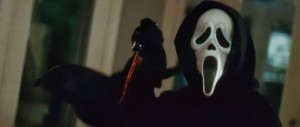
If Ghostface had narrowed the scope to “What’s your favorite scary movie from 1990 to 1995” I think his victims would still be trying to find one.
Even though I’d let my Fangoria subscription lapse, I’d kept up with horror film production in the 90s. I knew that Wes Craven, creator of the A Nightmare on Elm Street franchise, was working on a new slasher film… and I wanted nothing to do with it.
Though I idolized Craven growing up, due exclusively to the Nightmare series, the director’s later works were crap.
I was unimpressed and felt betrayed by Craven’s incoherent and bloodless 1989 slasher Shocker — though I have since come to love the film for the over-the-top “schlocker” that it is. Then in 1991 I raced opening weekend to see The People Under the Stairs, and was simply bored.
I still didn’t learn. I became ecstatic when I heard Craven’s next film would be a return to the Elm Street series, the director promising to make Freddy frightening once again. When I walked out of Wes Craven’s New Nightmare I felt I had seen my last Craven film. You can hear my full New Nightmare review in the Now Playing Podcast archives, but I truthfully wondered how I ever idolized this man who seemed able to only make terrible movies.
That line of thought was cemented with 1995’s Eddie Murphy horror comedy Vampire in Brooklyn, a film I saw out of devotion to Murphy, not Craven.
So in 1996, hearing Craven was going to make a new horror film was actually a turn-off. In ‘96 I would have rather gone to theaters to see Lawnmower Man 2: Beyond Cyberspace than Craven’s Scream.
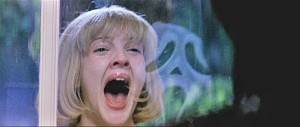
Scream turned Barrymore into an A-list star once again.
The cast did nothing to change this impression. Press materials touted Drew Barrymore’s role, and that seemed a bad sign. Back then she was still the little girl from E.T. who, like so many child stars, had developed a dependency problem. While I had seen her work in Boys on the Side and Mad Love I thought her heyday was behind her; the only roles she had in major releases were bit parts in Wayne’s World 2 and Batman Forever. She seemed “over” in Hollywood. I would never have guessed that, thanks to Scream, Barrymore was poised for a return to superstardom.
The rest of the cast — actors I’d not heard of or knew only from television shows — also failed to grab my attention. The only cast member that caught my interest was Matthew Lillard, whose zany performance I’d loved in Hackers, yet that was not near enough for me to want to see this movie in theaters.
Most of all, the film’s trailers didn’t hook me. I thought the killer’s mask was silly — had Michael Myers and Jason Voorhees taken all the good killer masks? I admit I was intrigued by the thought of characters that knew horror movie tropes; I mean, this was a horror movie where the characters were people like me. Still, with Craven’s name on the poster I wanted nothing to do with it.
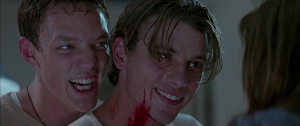
Lillard would go on to the Scooby Doo films after himself being unmasked as the bad guy in Scream.
I saw Scream in theaters only because I was invited by a group of friends and my options were to go to this movie or stay home alone. I wasn’t happy about going, and I anticipated a wholly miserable People Under the Stairs type of experience.
To say I was won over is an understatement. The film did have a good deal of true horror, with the opening murder scene a suspenseful highlight. With the scares firmly established, the movie achieved a near-perfect balance between self-referential humor and legitimate tension. While, due to my age, I was not afraid, the film did succeed in making me jump a couple of times.
In 2011 I gave my full review of Scream as part of our retrospective series leading up to Scream 4, so I will not repeat myself here. You can listen to that full review for a blow-by-blow analysis by Stuart, Marjorie and myself.
In short, not only did Scream win me over; I feel it is Craven’s best film — even better than my beloved A Nightmare on Elm Street.
I believe Craven was greatly assisted by the script from first-time screenwriter Kevin Williamson. Having seen many films made from Craven-penned scripts, none come near Scream in terms of plot twists, fleshed-out characterizations, and careful plotting. The movie was a whodunit, something I didn’t expect in a slasher. After all, in most slashers I knew the killer was Freddy or Michael or Jason or Chucky. That the killer was one of the kids was a fun experience — me trying to outwit the characters and peg the killer. When the mask is removed and the full story revealed, even I was taken aback by some of the twists. This is all Williamson, and I give him full credit for the film’s quality.
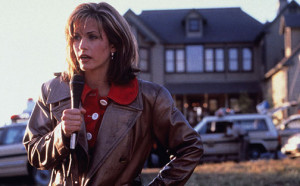
I watched Friends, but never saw Cox as a good fit for horror. Again, I was wrong.
Yet I cannot overlook Craven in the director’s chair. While the script was great, Craven brought two decades of horror experience to Scream. He knew how long to hold a moment, how to reveal a body, and how to build tension that would climax with a jump scare.
My heart was racing as I left the theater. This was the first great original horror film I’d seen in many years, yet had I known the long-lasting impact Scream would have, my exuberance would have been even greater.
The movie went on to make nearly $175 million on a $15 million budget, reminding Hollywood that a good horror movie can provide substantial returns.
Scream single-handedly revived the entire horror genre. The next year gave us not only Scream 2, but also — thanks to Williamson’s success — the enjoyable, but forgettable, I Know What You Did Last Summer.
We also got the Wes Craven-produced Wishmaster, which I saw in theaters and found a weirdly awful throwback to the days of Leprechaun.
By 1998, other studios had caught on and the post-modern, self-aware horror film had its heyday with Bride of Chucky, Halloween H20, Urban Legend and The Faculty. The quality was mixed, but all were far better films than Lawnmower Man 2 or The Curse of Michael Myers.
Scream made me appreciate Craven’s ability, but even more its success spawned dozens of films I’ve enjoyed over the past 20 years. For that reason alone, if not just for the movie itself, Scream might just be my favorite scary movie.
Tomorrow — 1997!
Arnie is a movie critic for Now Playing Podcast, a book reviewer for the Books & Nachos podcast, and co-host of the collecting podcasts Star Wars Action News and Marvelicious Toys. You can follow him on Twitter @thearniec
August 26, 2014 Posted by Arnie C | 40-Year-Old Critic, Movies, Now Playing Podcast, Podcasts, Reviews | 1990s, 40-Year-Old Critic, A Nightmare on Elm Street, Enertainment, Film, horror, Kevin Williamson, Movie, Movies, Now Playing, Now Playing Podcast, Podcasts, Review, Reviews, Scream, Slasher, Wes Craven | Comments Off on The 40 Year-Old-Critic: Scream (1996)
40 Year-Old-Critic: Hellbound – Hellraiser II (1988)
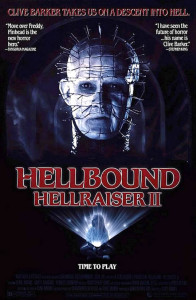 In The 40-Year-Old Critic, Venganza Media creator and host Arnie Carvalho recalls a memorable film for each year of his life. This series appears daily on the Venganza Media Gazette.
In The 40-Year-Old Critic, Venganza Media creator and host Arnie Carvalho recalls a memorable film for each year of his life. This series appears daily on the Venganza Media Gazette.
When I was young I was scared of horror. Not horror films, mind you, but the actual concept of horror petrified me. I mentioned in my earlier article discussing 1979’s Love at First Bite that even watching Dracula on television required an adult be home to protect me.
Yet, I was curious… I wanted to see it while I was frightened of what I might find.
The best analogy I can use for my view of horror is, indeed, the Lament Configuration puzzle box featured in the Hellraiser movies. I was a voyager seeking forbidden knowledge, but once the box was opened the pleasures, and terrors, inside would forever be unleashed. If I watched a horror film the hooks would be in my flesh, and what I would see were images relegated to the domain of nightmare.
I wanted to go there, but I took tentative steps over several years. As a very young child I stuck mostly to the safe horrors of Scooby-Doo ghosts and the seemingly supernatural mysteries in The Three Investigators young adult novels. At age 7 I tried to stretch my own limits by leaving the safety nets of kiddie fare behind and attempting to endure adult horror.
I saw The Shining on television in the early 1980s and was petrified by the decaying woman in the bathtub. I watched Frank Langella in Dracula around the same time. I would see ads for horror films like Return of the Living Dead, Friday the 13th, and Psycho III, read the reviews, and talk endlessly about them with classmates.
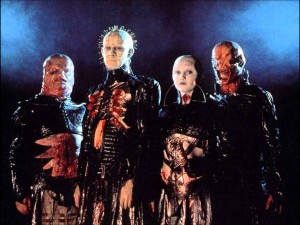
Like the cenobites I too wanted to explore the further regions of horror.
Finally, when I was 8 years old, I tried to face horror. I came home from school one day to find our hosted teenage exchange students were watching Friday the 13th on the VCR. My afterschool ritual was to watch a movie, often Star Wars or Grease, but these Brazilians had monopolized the machine. I was not going to change my routine, so if I could not pick the movie then I would just watch theirs. Not five minutes passed before I saw Mrs. Voorhees decapitated and I fled the room.
That image haunted me for years.
But as I grew into adolescence I wanted to stretch my boundaries further, and I did, starting with horror novels. I found the page safer than the screen, as the written word was always limited by the boundaries of my own imagination. I went further at age 12 and had my first horror movie marathon with the A Nightmare on Elm Street 1 and 2. While I did have a few nightmares of my own I loved every minute of it. I immediately started to consume all the horror I could, reading Fangoria magazine and watching more Stephen King films, the Friday the 13th series, Child’s Play, The Lost Boys, and more.
Within a year I was still captivated, but also starting to bore of the same routine. The vast majority of horror films I watched were slashers, each starring a new group of stereotypical teen characters taken to the slaughter. I had entered the realm of horror to stretch my boundaries, but I just found the same stories again and again. I had faced those fears and I wanted more. I wanted to be tested anew.
Then came Hellbound: Hellraiser II. I had known about the original Hellraiser from the ads. Stephen King’s words were put on the movie screen in a giant font: “I have seen the future of horror and his name is Clive Barker.” Trailers for the first Hellraiser raised my curiosity but the film never came to my town. In 1988, before I’d even had a chance to see Hellraiser on video, its sequel Hellbound came to theaters. The monstrous-looking Cenobites graced the poster. In the movie these creatures described themselves as, “Explorers in the further regions of experience. Demons to some, angels to others.” They were just what I wanted.
Being only 13, I couldn’t find any adult foolish enough to take me to see Hellbound. My parents were lax and would buy me tickets to A Nightmare on Elm Street films, but something about the Hellraiser series made them nervous. I had to wait for video, but the day Hellbound hit VHS I rented it and its predecessor.
I don’t know what I expected the movie to be, but my memory was of fevered excitement. I was going to see something forbidden; I expected something akin to a snuff film. I expected to be changed.
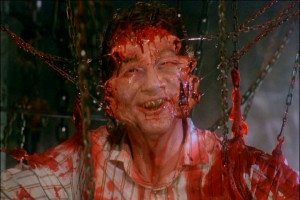
I wanted extreme…I got it. This was one of the first frames I saw of Hellraiser.
By complete accident I put Hellbound in the VCR first and it opened with a montage of the goriest, scariest scenes from the first film. I saw Larry (Andrew Robinson), his flesh stretched by hooks on chains. His distended face leaked more than just blood, and he slurred a blasphemous “Jesus… wept” before exploding into chunks of flesh.
Just these opening frames of Hellbound were an orgy of death and carnage. I was scared. I was nauseated. I was excited. I couldn’t bear to watch, yet I couldn’t turn away.
I had found exactly what I wanted in that damned puzzle box.
Eventually the opening credits started and I hit “stop” so I could watch the films in the correct order. I realized that this was not a Faces of Death-type snuff film but rather a mostly conventional horror film with a crazy woman seducing men and then killing them. Still, I had found a horror more pure, and more imaginative, than even Freddy. Pinhead and his varied demonic cohorts were immortal evil incarnate.
The first film had the better gore, but the second expanded the world further. In Hellbound we got to see the creation of a cenobite and travel to their labyrinthine realm; all taking place in an insane asylum — the heart of madness.
Yet the entire mad experience was accompanied by an amazing orchestral score by Christopher Young. From the disarming lullaby that played when the box was opened to the crescendos that sound like the soundtrack for the end of days, Young’s score stuck with me every bit as much as the latex work. I was no fan of Young’s given his “whale song” music for A Nightmare on Elm Street 2: Freddy’s Revenge but he redeemed by Hellraiser. I’ve still not heard a score he’s done better.
In the years since seeing Hellbound I have encountered many horror fans who claim the original Hellraiser is the only one worth watching. I disagree. Perhaps it was because I experienced them as a double-feature, prompted by the marketing for Hellbound, but I see the first two Hellraiser films as parts of a whole.

The matte work may not be cutting edge but Hellbound expanded the mythology of the Hellraiser franchise.
Yes, the first movie had a more visceral feel, but it also had long scenes of Kirsty Cotton (Ashley Lawrence) walking the streets of London. The sequel truly fulfilled Kirsty’s character arc and allowed her to escape the madness forever, or at least until the direct-to-video Hellraiser VI.
After seeing Hellraiser and Hellbound I felt I had gone to the limits of horror. I tried to explore further by reading Clive Barker’s books and seeing his follow-up films Nightbreed and Lord of Illusions. They couldn’t live up to the horrors of Hellraiser.
Repeatedly I’ve felt that Barker is the man who comes closest to taking the terror of nightmares and putting it on the page or screen, but he always falls just short.
For more than a decade the Hellraiser duology would be my bar for terror and horror, and they are both films I appreciate to this day.
I continue to try and find new boundaries to push in every aspect of life. I find contentment to be equal to death and I want to be pushed further. In the 25 years since first seeing Hellbound I’ve discovered films that grossed me out more (Human Centipede comes to mind), but none that felt as forbidden as the first two Hellraiser films.
I will continue to find the next cinematic puzzle box, and when I find it I’ll open it without hesitation.
Tomorrow: 1989!
Arnie is a movie critic for Now Playing Podcast, a book reviewer for the Books & Nachos podcast, and co-host of the collecting podcasts Star Wars Action News and Marvelicious Toys. You can follow him on Twitter @thearniec
August 18, 2014 Posted by Arnie C | 40-Year-Old Critic, Movies, Now Playing Podcast, Podcasts, Reviews | 1980s, 40-Year-Old Critic, Barker, Books, Books & Nachos, Cenobite, Clive, Clive Barker, Enertainment, Film, Hellbound, Hellraiser, horror, Movie, Movies, Now Playing, Now Playing Podcast, Pinhead, Podcasts, Review, Reviews, Sequel | 1 Comment
Freddy Fans Delighted at Flashback Weekend
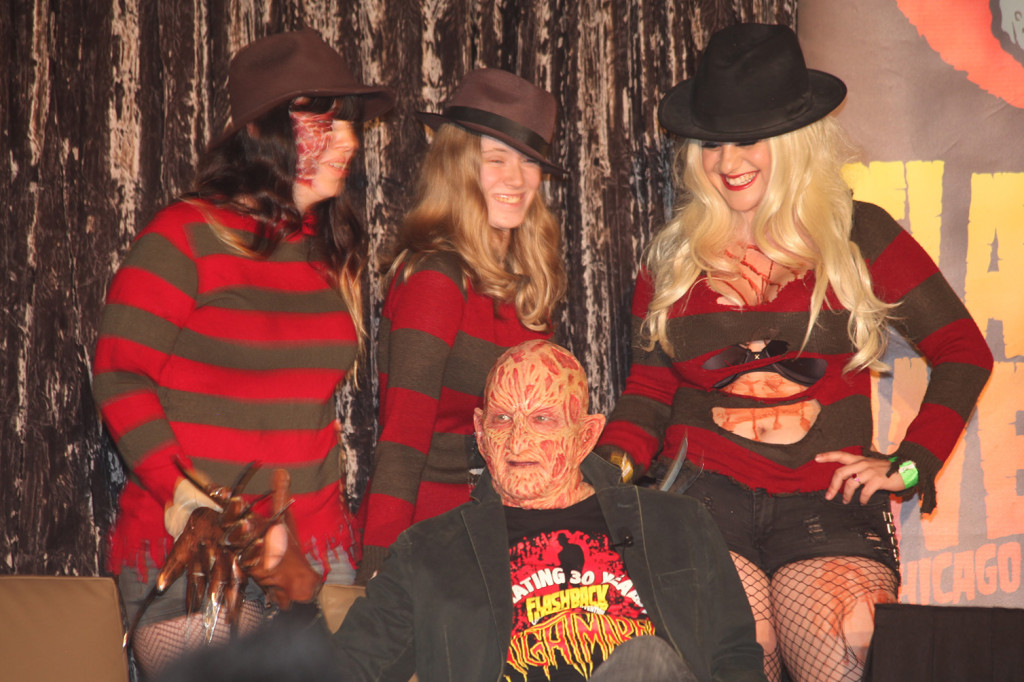
Freddy Kruger (Englund) on stage with three costumed back-ups at the Flashback Weekend Horror Convention
Rosemont IL – Despite being known for his Nightmares, actor Robert Englund made fans’ dreams come true last weekend at the Flashback Weekend Chicago Horror Convention.
Making a rare midwestern appearance, star of the Nightmare on Elm Street movie series Robert Englund was Flashback Weekend’s headline guest. Englund spent all day Saturday and Sunday meeting fans, signing their memorabilia, and sharing stories of his life from the making of A Nightmare on Elm Street to The Mangler and more. Fans lined up for hours to meet this horror icon.
Though the staff at Flashback Weekend had a convenient ticketing system to minimize wait times, Englund’s autograph line still wound out of his private room. Even those with $110 “priority line placement” tickets stood in line for nearly three hours. Once the fans reached the front of the line, though, the experience was rewarding. Englund is known to have a slow autograph line as he spends a few minutes talking with each fan. I watched as he fawned over one fan’s Japanese theater program promoting the release of 1989’s A Nightmare on Elm Street 5: The Dream Child. “You have some cool shit,” he said to another fan who brought a DVD collection covered in autographs from other stars.
The long line may have had its advantages. One congoer recounted his experience in Englund’s autograph line seven years ago at Flashback Weekend: he met his wife in that line. Now he, his wife of five years, and their daughter returned to again visit their horror hero.
The cost of Englund’s autograph was $50.00 per item–a very reasonable price for con-goers. (For comparison, at the upcoming Wizard World Chicago convention The Incredible Hulk’s Lou Ferrigno is charging $40.00, Marvel Comics’ Stan Lee $80.00, and, at New York Comic-Con in 2013, Sylvester Stallone charged $395.00). While some celebrities rarely look up from their tables, their hands furiously signing item after item, Englund ensured each fan felt they had their moment with him and a story to tell as they left.
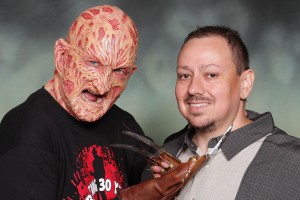
Arnie seized the opportunity to get a once-in-a-lifetime photo with Englund in the Freddy makeup.
While the chance for Robert Englund’s autograph was welcomed by the fans, the far more publicized event was Friday’s exclusive photo opportunity with the star–in full Freddy make-up. While celebrity appearances and photo opportunities are regular occurrences at conventions, rarely do the stars dress up for the occasion. On Friday, however, Englund underwent a two-and-a-half hour make-up application transforming him into the onscreen persona of Freddy. The latex prothetics that turned Englund into his on-screen persona were created and applied by 30-year Hollywood makeup effects artist Robert Kurtzman, who worked with Englund on the fifth Nightmare film.
The cost was very high– the photo opportunity, consisting of a professionally lit shot done by Celeb Photo Ops, a single 8″ x 10″ photo printout, and weekend admission to the convention (for one person) cost $365.00. Up to two people could be in the photo, but the guest would have to pay admission separately. The night of the event the photo itself could be purchased separately for $295.00. Additional prints and digital download options added to the cost of the photo. By comparison, at Wizard World Chicago photos with a single celebrity, also done by Celeb Photo Ops, range from $40 to $125, with the average being $55. A photo with all seven stars of Star Trek: The Next Generation is in the same price range, at $299.00 (not including convention admission).
The cost was not due to organizer or celebrity greed. Flashback Weekend started in 2002, run by Mike and Mia Kerz. The event is held annually in the Chicago area., and all proceeds from Flashback Weekend, including the Freddy photo op, go to the preservation and operation of the Midway Drive-In located in Dixon, IL. The Flashback Weekend web site states the philanthropic efforts are to “[provide] a theatrical outlet at the Midway Drive-In for new independent horror films [and maintain] a venue at the Midway for the screening of 35mm horror films.” Englund cited this cause as a motivator behind his decision to appear in full make-up.
Despite the high cost, hundreds of fans lined up for this once-in-a-lifetime photo opportunity. Fans came from across the country, some traveling from Tuscon, Pittsburgh, and Texas, for this chance. Englund was in full-on Freddy mode, speaking in the gravely voice and sometimes letting out his trademark scream–acts which must be second nature for the actor who’s portrayed the dream killer for thirty years. Fans hoping for a moment with their idol, however, needed to go to the autograph area as the photo op was a workman-like assembly line. Englund seemed to have four key poses: for photos with one person he would put his blade to their throat. For photos with two people he would attack one–usually the female. For families that snuck a third person, a child, into the photo Englund would grab the young one’s hair, and for those who were wearing their own Freddy glove Englund had a crossed-blades pose.
The entire photo experience gave fans about thirty seconds with the star before the man behind the camera shouted “next” and fans were escorted out. Englund seemed to barely have time to acknowledge any fans individually, it was enter frame, pose, picture, done.
However the result is a well-lit, framed, and shot photo. Yes, the cost is high, but, as shown to the right, the result is a photo that cannot be gotten anywhere else.
In the weeks leading up to the convention several fans complained online about Englund wearing the makeup and glove, but eschewing Freddy’s trademark sweater and hat. On stage that evening, in a private event for those who purchased the photo opportunity, Englund explained the hat created numerous lighting problems that plagued the filming of all the Nightmare films. For the sake of a good photograph the hat had to be skipped. As for the sweater? Englund explained that fans could find convincing Freddy characters in front of Mann’s Chinese Theater and other locales, and that by wearing the official T-Shirt of Flashback Weekend fans could prove their photo was with the star himself.
Also in that evening panel Englund stated that this was perhaps not, as claimed on the Flashback Weekend web site, the final time the actor would don the make-up; the 68-year-old actor may not yet be ready to hang up his hat and glove. Whether for other fan events or professional Hollywood productions fans may not have seen the last of Englund as Freddy after all.
And Englund wasn’t the only Nightmare on Elm Street star on hand for Flashback Weekend. Also at the event were Amanda Wyss (A Nightmare on Elm Street, Better Off Dead), Robert Rusler (A Nightmare on Elm Street 2: Freddy’s Revenge, Weird Science, Sometimes They Come Back), Jennifer Rubin (A Nightmare on Elm Street 3: Dream Warriors, Bad Dreams, Screamers), Monica Keena (Freddy vs. Jason, Dawson’s Creek), Katharine Isabelle (Freddy vs. Jason, Ginger Snaps) and Ronee Blakley (A Nightmare on Elm Street and Nashville, for which she was nominated for an Academy Award). Unlike Englund, lines to meet these actors were often short, and autograph prices ranged from $20.00 to $40.00. Some would pose with fans for photos if you purchased an autograph; others had a separate photo charge.
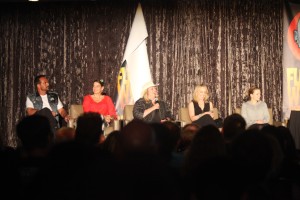
A Nightmare reunion at Flashback Weekend 2014! From left to right: Rusler, Rubin, Blakley, Wyass, and Keena
But like Englund each of the stars were approachable and friendly, engaging with their fans in the short time allotted.
In total, over two dozen celebrities attended the convention, including actress/musician Traci Lords, Gremlins star Zach Galligan, and character actor William Forsythe. These actors filled the end of the convention’s exhibit floor, and while, at peak times, lines became difficult to navigate, the average wait was short.
Aside from Englund, the two most popular celebrities at Flashback Weekends seemed to be Lance Henriksen and Angus Scrimm.
Henriksen is a science fiction fan favorite with appearances in three of the Alien films, as well as Terminator and the TV series Millennium. In total the actor has over 200 on-screen credits in a career that spans more than 50 years. Yet Henriksen engaged fans eagerly, sharing stories of knife-practice on the set of Aliens or “alimony movies” he had to make like The Mangler 2. He had a dry wit which left interviewer “Svengoolie” Rich Coz nonplussed during the Friday night panel.
Scrimm, an actor best known for the Phantasm horror series, had a autograph line second in length only to Englund’s. The actor, who is celebrating his 88th birthday next week, had a health issue that caused him to cancel an Indianpolis convention appearance in 2013. Fans, not wanting to miss this opportunity, stood in a line that at times stretched the length of the convention hall.
Scrimm headlined a 35th Anniversary Reunion of Phantasm stars at Flashback Weekend, which also included Reggie Bannister, Don Coscarelli, Michael Baldwin, Bill Thornbury, and Kathy Lester.
Outside of celebrity appearances, Flashback Weekend had a bevy of costumers and revelers. In addition to Svengoolie, local personalities Kitty Zombie, WGN Radio’s Nick Digilio, and Daily herald film critic Dann Gire helped host the event. While the convention’s exhibit floor was one of the smaller ones for Chicago conventions, fans still could buy toys, T-Shirts, DVDs, and more. For those whose tastes run outside the norm there were also taxidermied animal heads, lifelike silicon werebabies, and replica Freddy gloves.
Details for next years event are expected in the coming months at the official Flashback Weekend website.
See photos from the event in the galleries below.
-

- You can buy these old trading cards at Flashback Weekend but, as the company name states, Don’t Eat The Gum!
-

- What did the fox say? Nothing after they cut off his head and taxidermied it for sale at Flashback Weekends.
-
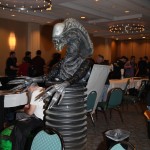
- Behind Lance Henriksen’s table stood an Alien prop; one of the must-sees on the exhibit floor of Flashback Weekend 2014.
August 11, 2014 Posted by Arnie C | Conventions, Movies, News | Alien, Chicago, Chicago IL, Children of the Corn, convention, Flashback Weekend, horror, Horror Movie, Lance Henriksen, Movie, Movies, Nightmare on Elm Street, Robert Englund, Traci Lords | Comments Off on Freddy Fans Delighted at Flashback Weekend
40 Year-Old-Critic: Carrie (1976)
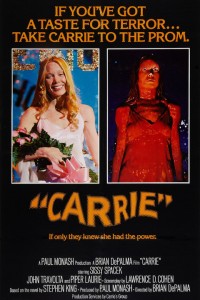 In The 40-Year-Old Critic, Venganza Media creator and host Arnie Carvalho recalls a memorable film for each year of his life. This series appears daily on the Venganza Media Gazette.
In The 40-Year-Old Critic, Venganza Media creator and host Arnie Carvalho recalls a memorable film for each year of his life. This series appears daily on the Venganza Media Gazette.
Last October, prompted by the release of the remake, Jakob, Stuart, and I reviewed 1976’s Carrie for Now Playing Podcast. It was the first film in our ongoing (with no end in sight) Stephen King Movie Retrospective. I came to that series a Stephen King fan, as I’ve followed his work since the mid 1980s. While researching Carrie for that review I realized I am likely only a Stephen King fan thanks to Brian DePalma’s film adaptation.
It’s not that I believe DePalma’s Carrie to be the best adaptation of a King novel, for proof you can listen to my thoughts in our Now Playing review. I think it’s a well-crafted and enjoyable film, but some poor characterizations and pacing issues prevent me from heralding it as the best King film to date.
I think Carrie’s greatest achievements took place off-screen.
King’s debut novel was published in April 1974, five months before I was born. Carrie sold well — especially in paperback — and secured the author a multi-book deal, but its overall performance was not exceptional. Even a year later, with the release of his second novel, Salem’s Lot, King was still not a household name. All of that changed in ‘76 when Carrie hit theaters. DePalma took that story, added his visual style and a Hitchcockian score, and the result was an Academy Award-nominated film.
I have no doubt that the success of Carrie in theaters gave King the boost he needed to achieve critical mass and have his first hardcover bestseller in 1977 with The Shining.
 It helps that King is a prolific storyteller, and I’ve always believed his appeal comes from engaging stories filled with relatable characters. No cinematic success can turn a poor writer into one of the bestselling authors of all time. But with Carrie, a spotlight was shone on King. He was exposed to a broader audience than the bookstore shelves could ever provide. De Palma opened the door and King had the talent to walk through it.
It helps that King is a prolific storyteller, and I’ve always believed his appeal comes from engaging stories filled with relatable characters. No cinematic success can turn a poor writer into one of the bestselling authors of all time. But with Carrie, a spotlight was shone on King. He was exposed to a broader audience than the bookstore shelves could ever provide. De Palma opened the door and King had the talent to walk through it.
The result is publishing history. I grew up going to schools where it seemed every third student was reading a Stephen King novel. Not only were my friends engrossed in the pages, but the parents of my friends were also reading King. I was enthralled. As a child drawn to horror — and simultaneously terrified of it — I couldn’t not read these books.
The first book I read was Carrie, suggested to me by lifelong friend and fellow Now Playing host Stuart. A few weeks after finishing the novel I saw De Palma’s film for the first time, and I became a Stephen King fan. He was the first author whose name would make me immediately interested in a book.
King has published 64 novels — most of them bestsellers — as well as countless short stories, and I have read most of them. I continue to read King as I enter my 40th year, and will continue through my 41st, 42nd, and so on, until one of us dies. I’m also reviewing every widely-published Stephen King story on our Books & Nachos podcast. As I write this I’m also working on a review of his ‘78 masterpiece, The Stand.
And it all goes back to DePalma’s Carrie. Without that film, it’s possible King would have been one of 1,000 authors who publish countless books for their niche audience, but never gain widespread attention. That film was a cultural phenomenon that shaped me as a person.
Tomorrow — 1977!
Arnie is a movie critic for Now Playing Podcast, a book reviewer for the Books & Nachos podcast, and co-host of the collecting podcasts Star Wars Action News and Marvelicious Toys. You can follow him on Twitter @thearniec
August 6, 2014 Posted by Arnie C | 40-Year-Old Critic, Now Playing Podcast, Podcasts, Reviews | 40-Year-Old Critic, Academy Award, Arnie, Book, Brian DePalma, Carrie, Fiction, horror, Novel, Now Playing Podcast, Oscar, Review, Stephen King, Telekenesis | 3 Comments
40 Year-Old-Critic: The Texas Chain Saw Massacre (1974)
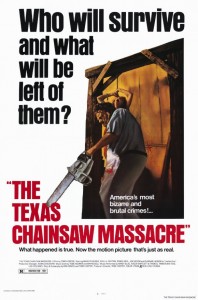 In The 40-Year-Old Critic, Venganza Media creator and host Arnie Carvalho recalls a memorable film for each year of his life. This series appears daily on the Venganza Media Gazette.
In The 40-Year-Old Critic, Venganza Media creator and host Arnie Carvalho recalls a memorable film for each year of his life. This series appears daily on the Venganza Media Gazette.
I was born in 1974, and if my parents took me to a movie that year I have no memory of the trip. In the 40 years since, I’ve caught up on many of the classics from that year such as The Godfather Part II, Blazing SaddlesThe Conversation, and Young Frankenstein. But, truthfully, none of those pictures shaped my life nearly as much as the small indie film The Texas Chain Saw Massacre.
Of course, I didn’t see this film in its original release. I was only 19 days old when Texas Chain Saw hit theaters. And while my parents were pretty lax with the content of movies I watched or books I read, even they would have had serious concerns about my watching teens carved up for food. I got into true, hard R-rated horror films when I turned 12, and the constant Chain Saw references in the 1987 Mark Harmon film Summer School had me finally rent this grindhouse film on VHS.
I was unimpressed.
I had built Leatherface up in my mind as a Freddy, a Jason, or a Michael Myers. But, in truth, Leatherface had none of the slick, commercial appeal of those later imitators. As such, the film was less fun for me as a teen. I later returned to Texas Chain Saw in 2010 for Now Playing Podcast’s retrospective series and, to the shock of many listeners, I gave it a red arrow. The cacophonic score, annoying performances, and dirty, low-budget look of the film still made it a movie I couldn’t enjoy. I labeled it “horror homework” — great for aficionados of the genre but not a film I’d recommend for the masses.
But while I may not recommend watching the film I truly recognize there are few films more important than this. It is no exaggeration to say that without The Texas Chain Saw Massacre the horror films I love may never have come to be.
First, Texas Chain Saw was a hugely successful film, costing only $300,000 to make and grossing over $30 million at the US box office (which, per BoxOfficeMojo is more than $131 million adjusted for inflation). This showed studios that inexpensive horror films could make bank.
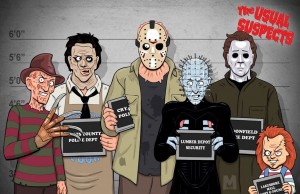 In addition to showing studios a pathway to profit, Texas Chain Saw also inspired screenwriters and directors. This film, along with Alfred Hitchcock’s Psycho, provided a template for the “slasher” sub-genre of film, combining a masked killer with an iconic weapon Later horror films like Halloween, Friday the 13th, A Nightmare on Elm Street, and even Scream and I Know What You Did Last Summer, all series that I love, took this formula and refined it for even greater success. And Leatherface’s greatest successor may just be Hannibal Lecter, another cinematic cannibal that has captured my imagination.
In addition to showing studios a pathway to profit, Texas Chain Saw also inspired screenwriters and directors. This film, along with Alfred Hitchcock’s Psycho, provided a template for the “slasher” sub-genre of film, combining a masked killer with an iconic weapon Later horror films like Halloween, Friday the 13th, A Nightmare on Elm Street, and even Scream and I Know What You Did Last Summer, all series that I love, took this formula and refined it for even greater success. And Leatherface’s greatest successor may just be Hannibal Lecter, another cinematic cannibal that has captured my imagination.
More, this film launched director Tobe Hooper into the spotlight, paving the way for him to direct Poltergeist, another seminal horror film of the haunted house variety. (And yes, we discussed how much influence Hooper had on Poltergeist in Now Playing Podcast’s 2011 Spring Donation Drive. Those podcasts are no longer available.)
While this film doesn’t click with me as entertainment, I credit Texas Chain Saw for paving the way for later horror films I love. This film was born the same time I was, and without it I would not be the man, or the movie critic, I am today.
I do, however, stand by that red arrow. As I found out when I was 13, this isn’t a film I can recommend for those looking for the same glossy thrill given by Friday the 13th Part VI. It is not a Hollywood production and it shows. But while I can’t recommend it, I love it for the future films it enabled.
Tomorrow — 1975!
Arnie is a movie critic for Now Playing Podcast, a book reviewer for the Books & Nachos podcast, and co-host of the collecting podcasts Star Wars Action News and Marvelicious Toys. You can follow him on Twitter @thearniec
August 4, 2014 Posted by Arnie C | 40-Year-Old Critic, Now Playing Podcast, Podcasts, Reviews | 40-Year-Old Critic, Arnie, Freddy, horror, Leatherface, Michael Meyers, Now Playing, Now Playing Podcast, Review, Texas Chain Saw Massacre, Texas Chainsaw Massacre, Tobe Hooper | 10 Comments
Leprechaun: Origins Coming in August from LionsGate
A Horror Icon is Reborn In This Reimagining Of The Terrifying Evil Behind The Hit Cult Franchise LEPRECHAUN
Starring WWE® Superstar Dylan “Hornswoggle®” Postl, The Film Arrives On Digital HD And Video On Demand August 26th From Lionsgate Home Entertainment
Available on Blu-ray and DVD On September 30th
SANTA MONICA, CA (June 5, 2014) – WWE Superstar Dylan “Hornswoggle” Postl stars in Leprechaun: Origins, a brand new take on the horror franchise Leprechaun, reinventing the cult favorite and terrifying a new generation. The film will be available on Digital HD, Video On Demand and Pay-Per-View on August 26, and on Blu-ray (plus Digital HD) and DVD (plus Digital) on September 30. Also starring Stephanie Bennett (Grave Encounters 2), Andrew Dunbar (Alien Trespass), Melissa Roxburgh (Diary of a Wimpy Kid: Dog Days) and Brendan Fletcher (Freddy vs Jason), Leprechaun: Origins was written by Harris Wilkinson and directed by Zach Lipovsky.
Backpacking through the lush Irish countryside, two unsuspecting young couples discover a town’s chilling secret. Ben (Dunbar), Sophie (Bennet), David (Fletcher) and Jeni (Roxburgh) quickly discover the idyllic land is not what it appears to be when the town’s residents offer the hikers an old cabin at the edge of the woods. Soon, the friends will find that one of Ireland’s most famous legends is a terrifying reality.
The Blu-ray and DVD include two behind-the-scenes featurettes and will be available for the suggested retail price of $24.99 and $19.98 respectively.
BLU-RAY/DVD SPECIAL FEATURES*
- “Leprechaun: An Icon Reborn” featurette
- “Leprechaun: Behind the Blood” featurette
*Subject to change
PROGRAM INFORMATION
Year of Production: 2014
Title Copyright: Leprechaun: Origins © 2013 Lions Gate Films Inc. and WWE Studios Inc.
Artwork & Supplementary Materials © 2014 Lions Gate Entertainment Inc.
All Rights Reserved.
Type: Home Entertainment Premiere
Rating: R for Horror Violence, and Language
Genre: Horror
Blu-ray Closed Captioned: English SDH
DVD Closed Captioned: English
Subtitles: English and Spanish
Feature Run Time: 90 minutes
Blu-ray Format: 1080P High Definition 16×9 Widescreen (1.78:1)
DVD Format: 16×9 Widescreen (1.78:1)
Blu-ray Audio: 5.1 DTS-HD Master Audio
DVD Audio: 5.1 Dolby Digital
June 9, 2014 Posted by Arnie C | Movies, News, Now Playing Podcast, Podcasts | Comedy, Hornswoggle, horror, Horror-Comedy, irish, leprechaun, Lionsgate, Movie, Movies, Now Playing Podcast, Warwick Davis, WWE | Comments Off on Leprechaun: Origins Coming in August from LionsGate
Film Fans of All Types Can Enjoy Days of the Dead
To someone who’s never been to a horror convention the thought could be as frightening as the blood-soaked splatter fests that appear on screen. One could imagine pale, pierced social misfits and psychopaths standing in line to meet their favorite serial killer. Many may feel if they aren’t into the gory or the grotesque then a horror convention is not for them.
That impression is totally false as shown last weekend at the Days of the Dead horror convention in Indianapolis. Of course it was a blast for those into fright films, but it also had entertainment to offer any movie lover!
One of the big draws of the convention were the large number of celebrity guests in attendance. The stereotype of a celebrity on the autograph circuit is an actor with his career on the decline, clinging to former fame. Days of the Dead proved that image wrong by bringing in several A-list celebrities promoting current films. Some of the headlining guests have big movies out soon included Danny Trejo (Machete Kills in October), Keith David (recently in Cloud Atlas and a dozen more films in production), and Academy Award Nominee Gary Busey (Behaving Badly due out this year). This is an amazing roster for a con only in its third year, besting some of the other national companies who host conventions in the Midwest.
Access to the celebrities was incredibly easy. At many conventions fans have to wait in line for four hours or more to meet their idols. At Days of the Dead my wait time to see Trejo was 10 minutes, and only 15 minutes for Busey.
More, the prices were very reasonable. At conventions such as Dragon*Con or San Diego Comic-Con I’ve paid over $100 for signatures from actors who have not worked in several decades. At Days of the Dead the majority of autographs were $20 and headliners Busey and Trejo were just $40. Trejo would take a picture free with an autograph, while Busey charged only $10 additional for a photo; at some conventions photo opportunities start at $20 and can be as high as $150.
While all of the celebrities have horror films on their resumes, Trejo would sign a copy of the comedy Bubble Boy as rapidly as the vampire film From Dusk ‘Til Dawn, and Busey had available photographs of his roles in Lethal Weapon and Point Break. I did not see anyone asking Keith David to sign their copy of Requiem for a Dream but I doubt he’d have declined.
All the guests were not just polite but completely engaged with the fans, having short conversations and truly making the con attendee feel appreciated. This is far better than the assembly-line like atmosphere found by some guests at Wizard World or New York Comic Con. In fact, the longest line to see a celebrity seemed to be A Nightmare on Elm Street 4 star Lisa Wilcox who would spend up to 5 minutes talking with her fans while signing their items. (Unfortunately for Wilcox one of those fans I observed was a socially awkward male in his twenties regaling her with a story about a specially lit photo he had of Wilcox in his bedroom…so while some of the stereotypes were present at the con most of the attendees were overwhelmingly normal).
Even the guests whose primary work was in horror had non-horror items available. For example, Wilcox is best known for starring in A Nightmare on Elm Street but the actress also had available a wide selection of photos from her single-episode guest-starring role in Star Trek: The Next Generation. As she rarely appears in the Midwest, Wilcox was a draw for Trekkers and horror fans alike. Original Nightmare on Elm Street star Heather Langenkamp also had a minor role in this summer’s Star Trek: Into Darkness.
Of course, the horror fan had much to celebrate. Icons of the genre including Tony Todd (Final Destination, Candyman, Wishmaster), Derek Mears (the Friday the 13th reboot, 2007’s The Hills Have Eyes II), Tyler Mane (Michael Myers in both Rob Zombie’s Halloween films), Leslie Easterbrook (Zombie’s Halloween and The Devil’s Rejects), several stars of Cabin Fever, and over a dozen more horror film character actors were also there.
The vendor areas of the convention were a shopper’s delight. While the non-horror fan would find less that appeals to them in the vendor booths, there were plenty of superhero toys and Star Wars collectibles to choose from. I bought an original painting based on the Howard the Duck movie!
Many booths catered to all children of the 80’s, including Don’t Eat the Gum – a company that sells trading cards from the 1980s and 1990s (and my wife should have listened to the company name as she almost broke her tooth on a stick of gum from Howard the Duck trading cards…the gum was made in 1986). Also there was Adjust Your Tracking selling movies on VHS that were never officially available on DVD.
Of course, being a horror convention, slasher-film fans could buy items not found anywhere else. Many booths offered DVDs of horror movies, including bootlegs of some incredibly rare films like Fright Night 2 and Silent Night, Deadly Night: Initiation.
There were also custom T-Shirts, paintings, and other original expressions of creative horror. At one booth Curious Goods offered custom action figures, including Rob Zombie, and Deathtroopers–Star Wars Stormtroopers turned zombies.
The exhibit floor was split into two small ballrooms, a sign that Days of the Dead is quickly outgrowing the space offered by the Wyndham Indianapolis West hotel. Having Days of the Dead split among several walled-off areas did make the convention feel smaller than it was. While it were ever too crowded, as is often found at larger conventions, the lines often crossed and merged, making celebrity areas hard to navigate. This is likely the product of becoming incredibly popular in only three years, and something I’m sure will be corrected at future conventions.
Overall Days of the Dead Indianapolis was an incredible experience, and I will certainly be attending their Chicago convention this November. While the only guests announced thus far are stars of the Return of the Living Dead and The Blair Witch Project it’s sure to be fun!
When not attending conventions across the globe Arnie can be found hosting the movie review podcast Now Playing, which has reviewed hundreds of movies of all genres, as well as the toy collecting podcasts Star Wars Action News and Marvelicious Toys. He also reviews books on the Books & Nachos podcast.
-

- Gnomes protect your flowers…by eating the babies that crawl by! Another gory custom from Curious Goods.
July 12, 2013 Posted by Arnie C | Comic Books, Conventions, Marvelicious Toys, Movies, News, Now Playing Podcast, Podcasts, Reviews, Star Wars Action News | Chicago, Comics, Curious Goods, Danny Trejo, Days of the Dead, Gary Busey, horror, HorrorCon, Illinois, Indiana, Indianapolis, Movie, Movies, News, Now Playing, Review, Television | Comments Off on Film Fans of All Types Can Enjoy Days of the Dead
The Collection Movie Review
The Collection
Director: Marcus Dunstan
Writer: Marcus Dunstan, Patrick Melton
Starring: Josh Stewart, Emma Fitzpatrick Christopher McDonald, Lee Tergesen, Randall Archer
Studio: Fortress Features Features
Release Date: September 21, 2012
Elaborate, fatal traps? Squirm inducing injuries? Copious blood? Combine these features with a sadistic and mysterious killer and you’ve got The Collection, a sequel to The Collector. The Collector was initially written as a prequel to Saw. When it was rejected, it became its own movie outright, spawning this franchise.
Arkin, having escaped from The Collector, is tapped by a private security team to tell them where he was held captive so that they can rescue Elena, the latest victim. He’s forced at gunpoint to enter the abandoned hotel that is the villain’s lair, in order to make sure that they get their target. As the team is picked off by the deadly concealed ambushes, they are astounded by the grotesque acts The Collector has committed to his victims.
The Collector likes to kill his victims using fancy mouse (human?) traps. Try to escape through a window and you’re likely to have your hand sliced off when you open it. Step on a certain spot on the floor and large spears will impale you. There’s a dotted line in the horror movie family tree from Jigsaw to The Collector. They seem fairly similar in operations. But The Collector lacks a motive. The novelty of Jigsaw was that he offered his victims a chance at redemption. Freeing oneself from the contraption was also freeing yourself from your past. There is nothing hidden here, these exist solely to kill. There is no redemption for any of the victims. The contraptions are not elaborate as they were in the Saw series. These try but they come off more as a deadly Home Alone movie.
The one thing this film does both very well is the character of The Collector. He is incredibly menacing as we have never seen his face nor has he ever spoken. He lurks, stalks and grabs with the precision of Michael Myers. He’s very mysterious with his lucha libre like mask and insect collection. The potential for a great serial killer is there with all of this covertness, but he is too unknown. There just aren’t enough character details to make him a great antagonist. Other than he collects one person to keep from every killing spree, we don’t know anything else about him. He’s portrayed as cryptic for cryptic sake but for no good reason. It was unfulfilling to know so little.
Instead of paying homage to the granddaddy of torture porn, The Collection comes off like a made for TV copycat movie. It’s similar enough to remind the viewer of its roots but it has just enough differences to escape plagiarism. There wasn’t enough originality to make this work and let’s be honest, if you’re going to emulate another franchise, do it bigger, badder and better. Although the murderer has potential, his details aren’t revealed enough to make him add anything more than a frustration. Even with razor blades held to my face, I wouldn’t recommend this movie.
April 10, 2013 Posted by Arnie C | Movies, Now Playing Podcast, Podcasts, Reviews | horror, Movie, Now Playing, Review, Slasher, The Collection, The Collector, Torture Porn | Comments Off on The Collection Movie Review
Would You Rather Movie Review
Would You Rather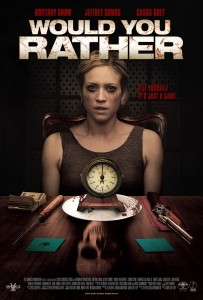
Starring: Brittany Snow. Sasha Grey, Jeffrey Combs, John Heard
Directed by: David Guy Levy
Once you RSVP, it’s too late…
Would You Rather takes an innocent slumber party game and twists it, replacing kissing the school dweeb with self mutilation. Reminiscent of the Saw franchise, this is torture porn with reduced gore. The concept of this movie is grotesque but it’s a safer, gentler release with less in your face graphic violence, all while maintaining an interesting and unique story.
Iris is dead broke after the death of her parents and desperately needs money. She accepts a mysterious invitation to a dinner party that promises the chance to win enough money to solve her problems. The party is hosted by Shep Lambrick (Jeffrey Combs), with the promise of one attendee winning money via an contest. The game is revealed to be “Would You Rather”, the party game that forces you to choose between two choices. Instead of choosing to kiss the their friend Martha or their friend Bob, the guests are astounded to learn that their choices are self mutilation or mutilating someone else. As each round progresses with a new painful challenge, guests are eliminated either by fatal injury or killed during an escape attempt leaving Iris and one other as the finalists.
Refreshing a stale genre, Would You Rather presents a new twist that is both unique and original. The writers rely on implied gore to create the suspense.
The mutilating challenges all sound horrible and conjure graphic images but it’s a stark contrast to what is shown. Lucas’s challenge is to slice open his eye. We hear his resistance, see his panic at the thought but when he actually does it, it is so quick and shot at such an angle that there is no blood. Peter’s challenge is to blow up a firecracker in his hand. It sounds simple enough until it’s revealed to be a quarter stick of dynamite and that it is duct taped thoroughly to his hand. When it explodes, the carnage is poorly lit so it’s impact is minimal and the focus is on Peter having a heart attack. Anything imagined is much worse than what is shown causing a much more intense movie.
Combs is delightful in his role as philanthropist turned sadist Shep Lambrick. Known for his stoic portrayal of Dr. Herbert West in Reanimator, he is wonderfully chipper and animated in Would You Rather. His delight and mockery at the moral dilemmas facing his dinner guests is fun to watch. He munches on snacks while they decide who they are stabbing, shocking or whipping. Combs doesn’t portray Lambrick as a maniac, he’s mostly a madman but with social skills. Combs has such a delightful giggle when he is enjoying tormenting his guests. It’s nice to see him break out and have some fun, even if it is at the expense of others.
Would You Rather is a nice twist on the overdone torture porn genre. It had become graphic for graphic sake (Saw) by replacing shock with copious amounts of blood. By relying on good old suspense and implied violence, Would You Rather takes it to a new level and keeps the audience entertained all the way to the surprise ending.
March 15, 2013 Posted by Arnie C | Movies, Now Playing Podcast, Podcasts, Reviews | horror, Jeffrey Combs, Movies, Now Playing, Review | Comments Off on Would You Rather Movie Review
Movie Review: Apollo 18
In space nobody can find your footage.
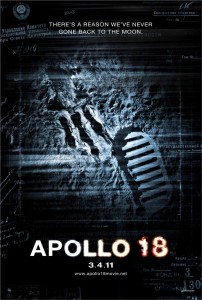 |
|
| Apollo 18 | |
| Director: | Gonzalo López-Gallego |
| Writer: | Brian Miller |
| Starring | Warren Christie, Lloyd Owen, Ryan Robbins |
| Studio: | Bazelevs |
| Release Date | September 2, 2011 |
For years, conspiracy theorists have long believed that NASA is up to no good. Between faked and secret missions to the moon, people have long suspected nefarious deeds in our space program. Enter Apollo 18, an alleged found footage movie that chronicles a previously unknown mission. Much like it’s genre predecessors, it’s supposed to fuel speculation but all it does is make the audience wish for a mission to end the movie.
Under the guise of secretly placing sensors to detect ICBMs from Russia, three astronauts are sent on an unpublicized trip to the moon. While on the moon, they encounter a Russian lunar unit with blood inside. Things start to fall apart when something is inside one of the astronaut’s suits. It ends up under his skin and when removed, it resembles one of the moon rocks. They then begin to theorize that their real mission is to place sensors to monitor these “rocks”.
If you are a fan of the genre or maybe a fan of some other popular movies, you may enjoy this movie. Almost every single plot device has been done previously and with a better result than in this movie. By borrowing from so many other movies, Apollo 18 can’t quite find it’s own footing. Too many scenes are reminiscent of other, better movies that it’s just not satisfying. The most glaring copy cat scene is when one of the astronauts uses a film camera to illuminate the crater where they find the cosmonaut. The use of the camera sounds, with the flash illuminating the crater’s horrifying sites is so similar to the opening of The Texas Chainsaw Massacre that I expected Leatherface to appear. The worst part of this analogous scene was that it didn’t accomplish anything. The images were so quick and poorly lit that it does not produce the any fear or expectations.
Aside from the lack of originality, the movie falls short on suspense. It’s not for lack of trying though. The filmmakers attempt to create confusion by showing rocks that move and hover. There’s also a mysteriously abandoned Russian ship where it appears there as a struggle. These scenes are so slowly paced that just can’t produce any tension. Because of this, the big reveal of the source of all of the issues – aliens falls flat. The bigger issue might be that the aliens are rocks instead of, you know, something scary. Granted, the rocks can float and they appear to turn into something with tentacles that resemble the facehugger from Alien, but the aliens are rocks about 99% of the time. There’s just nothing scary about a rock that floats. Not recommend.
March 4, 2013 Posted by Arnie C | Movies, Now Playing Podcast, Podcasts, Reviews | aliens, horror, space | Comments Off on Movie Review: Apollo 18
-
Archives
- February 2021 (1)
- January 2021 (1)
- December 2020 (1)
- November 2020 (3)
- October 2020 (2)
- September 2020 (1)
- August 2020 (2)
- July 2020 (1)
- June 2020 (1)
- May 2020 (1)
- April 2020 (3)
- March 2020 (2)
-
Categories
-
RSS
Entries RSS
Comments RSS
Site info
Venganza Media GazetteTheme: Andreas04 by Andreas Viklund. Get a free blog at WordPress.com.
